
Google Ads
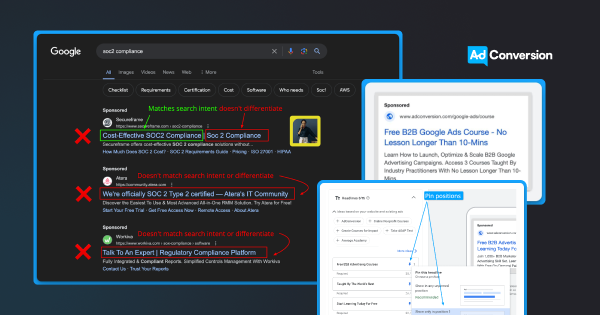
How to Write Effective Responsive Search Ads in 3 Simple Steps
Google Ads responsive search ads (RSA) don’t leave a ton of room available.
With 30 character headlines, and 90 character descriptions.
It’s tough to write persuasive and effective copy.
In this article you’ll learn a simple 3-step framework to write responsive search ads.
Let’s dive into it 👇
TABLE OF CONTENTS:
- The 3-Part RSA Writing Framework
- The Anatomy of a Responsive Search Ad
- Should you pin headlines and descriptions in Google Ads?
- Advanced copy tips for writing Responsive Search Ads
The 3-Part Google Ads RSA Writing Framework
Here's a simple 3-part framework for writing Google Ads copy:
- The goal of headline 1 = match intent
- The goal of headline 2 = differentiate between other results
- The goal of headline 3 = provide a clear CTA
Keyword: b2b google ads course
- H1: Free B2B Google Ads Course (matches intent)
- H2: No Lesson Longer Than 10-Mins (differentiates)
- H3: Join 1,000+ B2B Marketers (clear CTA)
Here's what it looks like in practice (image below):
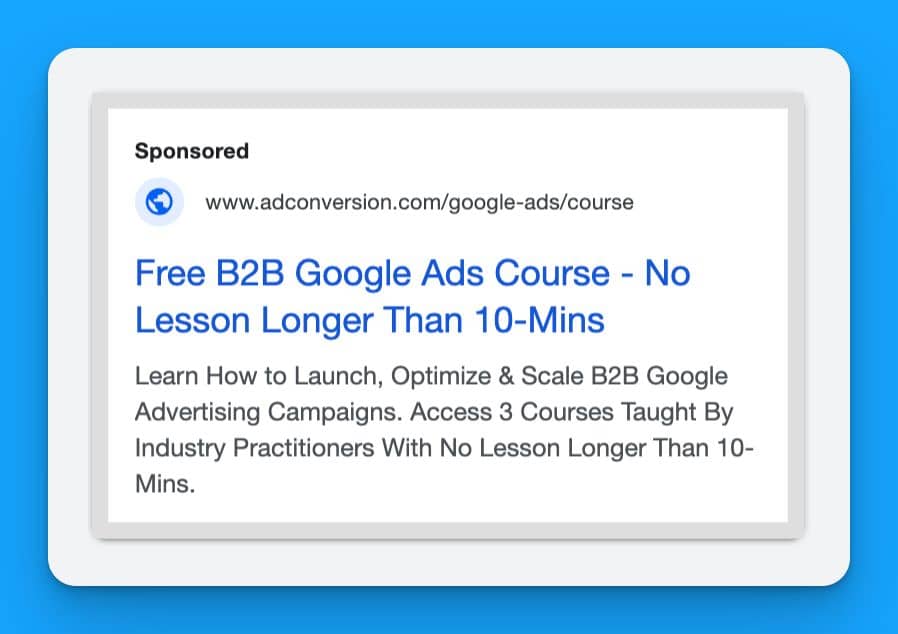
When writing, always assume the H3 isn't visible, and if only the H1 was displayed would they get it?
(Google is always testing different display variations)
From here you would write different variations per position.
With ensuring legibility between headline combinations.
Simple but effective ✌️let’s dive into each headline further.
The goal of headline 1 = match intent
You’ve got a fraction of a second for a prospect searching on Google to understand if your ad is relevant to their search term.
Don’t mess this up by being vague, asking rhetorical questions, or wasting valuable characters.

When it comes to Google Ads the headline 1 position would be eighty cents out of your dollar.
Maximize your headline 1 by adding the primary keyword in your copy to match intent.
This is such a simple thing to do, and equally not to.
The goal of headline 2 = differentiate between other results
Now that you’ve caught the searchers attention by matching intent it’s time to stand out.
Here’s a real example of what NOT to do from ads that appeared searching SOC2 compliance:
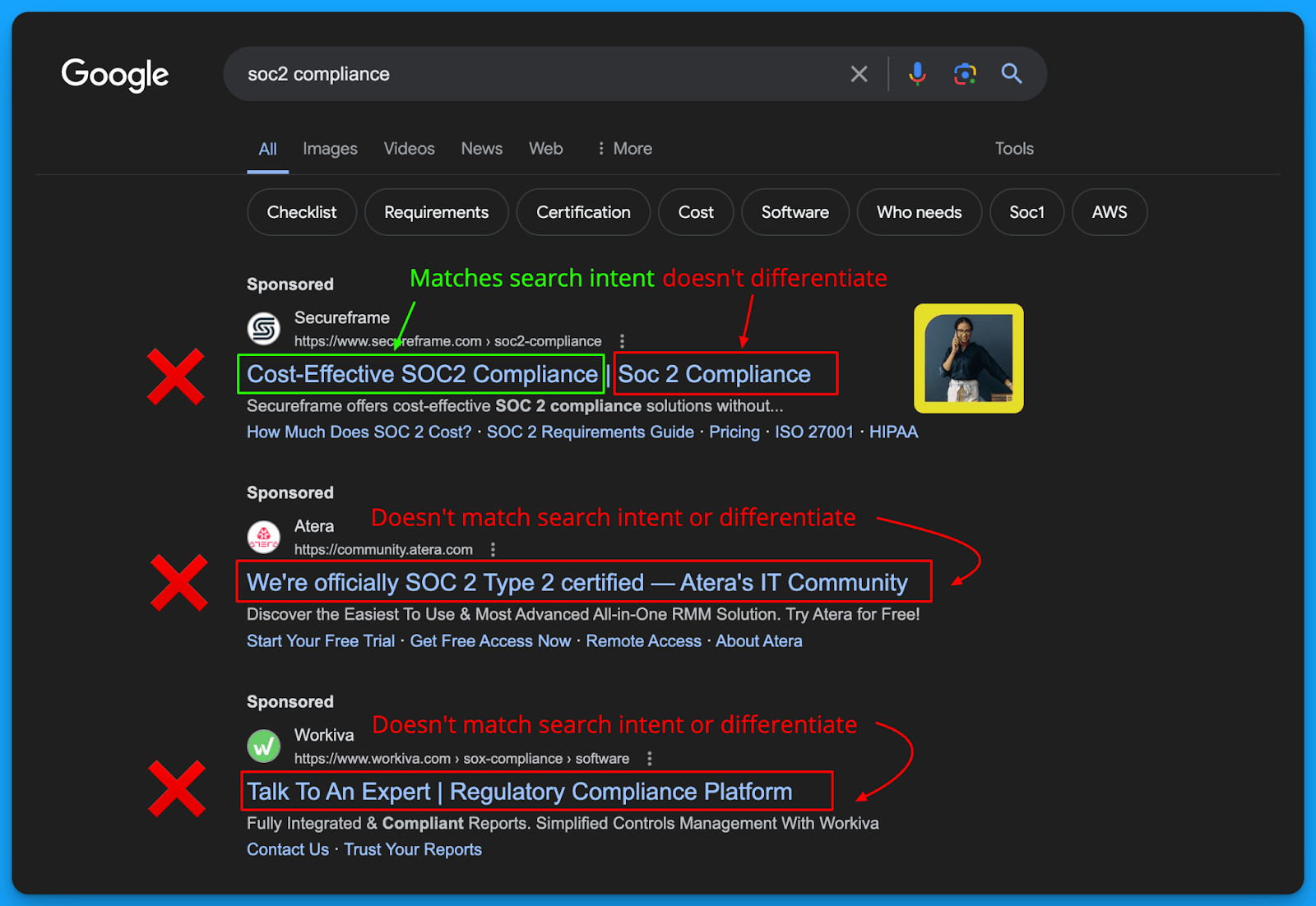
The sequence of which you write your headlines matter.
This is why I recommend following the 3-part framework as shown.
Use the headline 2 position to write a core benefit or outcome for differentiation.
The goal of headline 3 = provide a clear CTA
Finally in the third headline it’s time to provide a clear call to action.
This can be as simple as:
- Request a Demo
- See For Yourself
- Learn More Today!
When writing your H3 just assume it won’t be visible most of the time as Google is always experimenting with how they display headlines.
The Anatomy of a Responsive Search Ad
Now that you understand how to approach writing RSA copy.
Let’s discuss how responsive search ads actually function.
Character counts for Responsive Search Ads
- You can write up to 15 headlines, and 4 descriptions.
- 30 characters available per headline
- 90 characters available per description
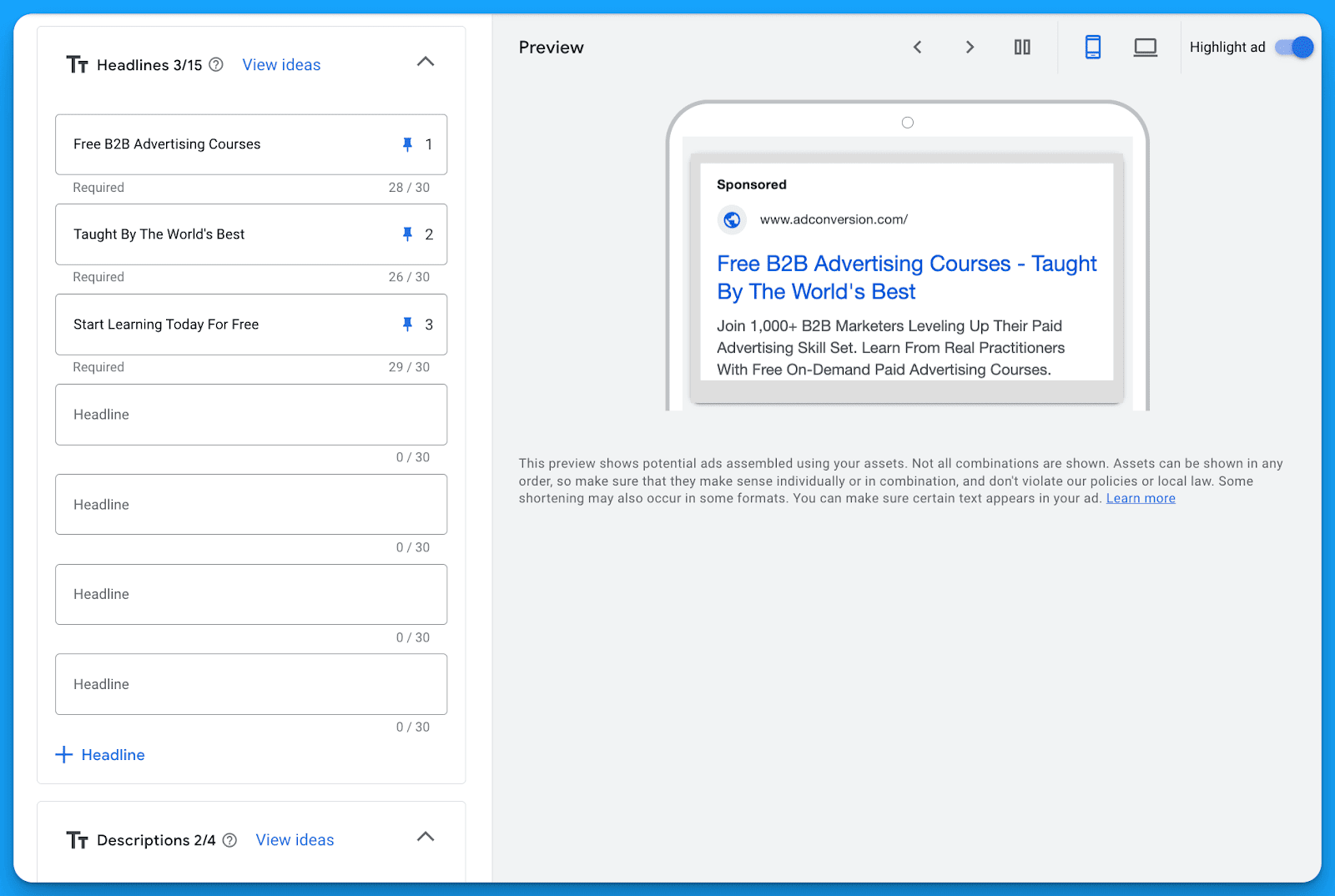
How Responsive Search Ads work
The idea behind responsive ads is Google will take your 15 headlines and 4 descriptions and automatically combine them to find the optimal variations based on machine learning.
The promise is you can leverage Google’s AI to do the heavy lifting as it will take into account a multitude of factors including keywords, search terms, devices, audience demographics and more.
Google also tries to guide advertisers on how well their doing when writing responsive search ads with their Ad Strength metric 💩(which we’ll cover in detail shortly).
With each headline and description you have the opportunity to pin positions.
This is where you’re forcing Google to only serve those variations within that specific placement.
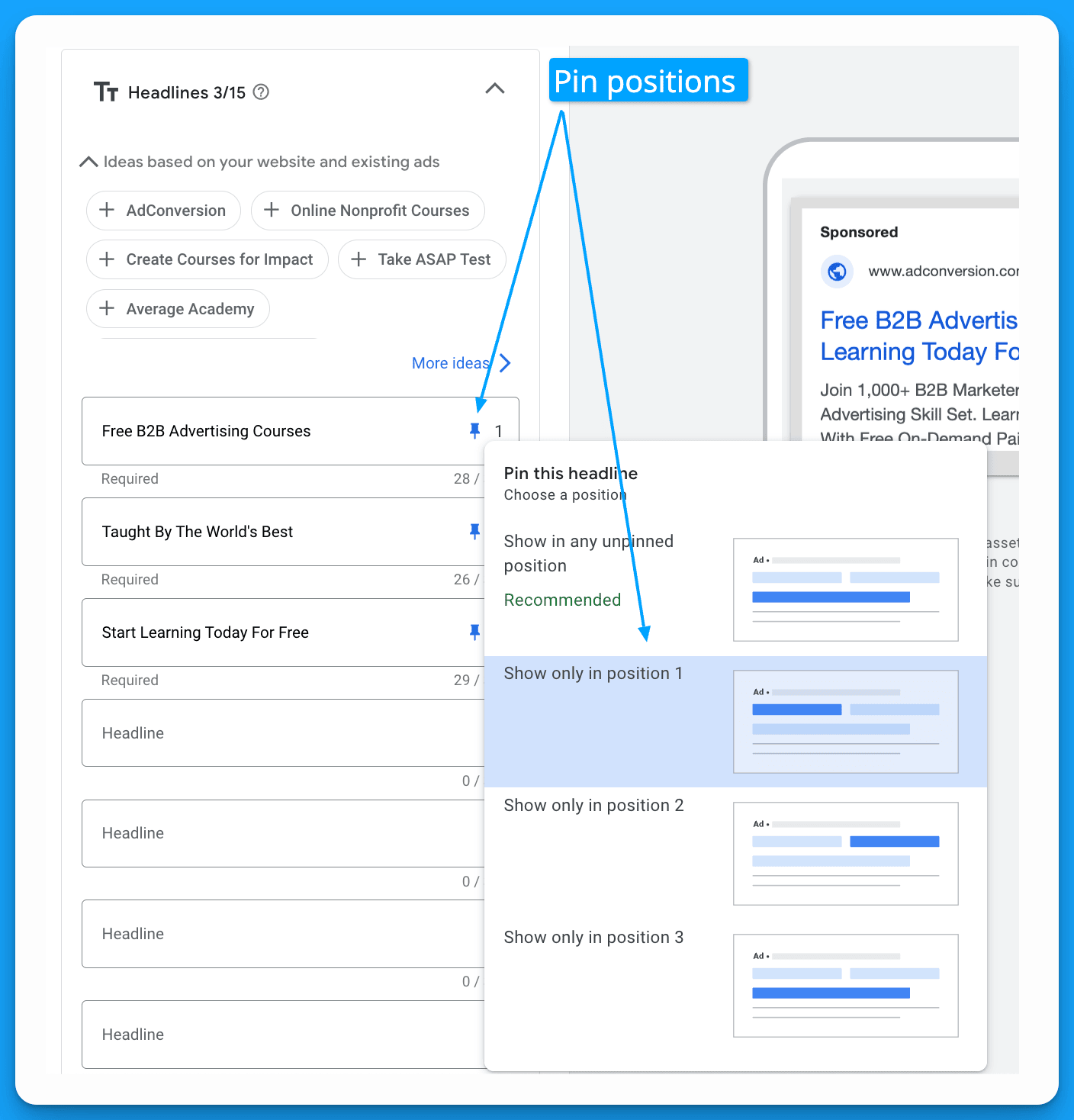
Should you pin headlines and descriptions in Google Ads?
The answer here is an unequivocal YES, because if your ads aren’t legible they won’t be clicked.
In a perfect world Google will automatically combine your headline and descriptions perfectly based on performance AND legibility but in reality it doesn’t happen.
Instead you end up with a bunch of variations like this:



I personally would LOVE ♥ ️ if Google’s AI can mix and match ads perfectly for performance and legibility but unfortunately the tech still isn’t there.
So in order to prevent this from happening I recommend strategic pinning.
How to pin Google Ads headlines strategically
In order to get the benefits of both Google’s AI to mix and match top performing headline/description combinations AND legibility you’ll need to pin strategically.
Here’s what it looks like in practice:
- Write 2-3 variations of Headline 1 and pin to position 1
- Write 2-3 variations of Headline 2 and pin to position 2
- Write 2-3 variations of Headline 3 and pin to position 3
- Write 2 variations of Description 1 and pin to position 1
- Write 2 variations of Description 2 and pin to position 2

This will give you the benefit of testing multiple variations per position but safely as you can control which possible combinations are matched for legibility.
What is Ad strength and does it matter?
Ad strength is a score created by Google to help advertisers optimize their ad performance ranging from Incomplete → Poor → Average → Good → Excellent.

Ad strength misconceptions to be aware of
- Ad strength has ZERO bearing on actual performance, it's just a predictor of it.
- Having a poor ad strength doesn’t mean your ad won’t actually perform well.
- Having a poor ad strength doesn’t mean your ads won’t receive impressions.
What determines if your ad appears is your Ad Rank.

Pin strategically with 2-3 variations of headlines and you’ll be ok, it’s also what Google suggests if you decide to pin.

Advanced copy tips for writing Responsive Search Ads
Now that you know how to write effective responsive search ads let’s wrap with some advanced tips you can implement to make your ads perform even better.
Implement Dynamic Keyword Insertion (DKI)
Dynamic Keyword Insertion allows you to change your ad copy in real time based on the keywords that are triggering your ads in order to create more relevant experiences.
Currently there are 3 types of DKI available:
- Keyword Insertion = insert the keyword that triggers your ad
- Countdown = insert a timer that counts down to an event
- Location insertion = insert the location that triggers your ad
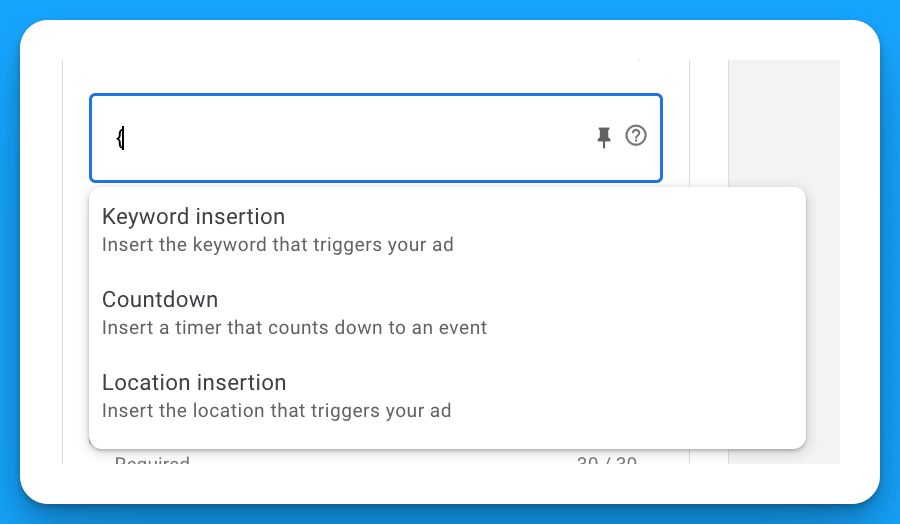
Test variations of your RSAs using relevant DKI parameters vs not to see if it impacts performance.
Leverage Business Name, Logo, and Image Ad Extensions
Now that Google allows you to highlight your business name and logo in your RSA, don't waste the characters anymore referencing your brand in your ad copy.
Save those valuable characters as you’re already getting brand awareness and instead maximize each character according to the 3-Part Google Ads RSA writing framework.
Ad extensions should always be used as a best practice but when it comes to writing effective Google Ads copy don’t forget to utilize your extensions to provide more information.
Hope you found this article helpful, best of luck on your next set of ads!
From Clicks to Conversions: Master Google Ads for B2B 🔥
If you want to become a Google Ads pro, check out our free B2B Google Ads courses, where you'll learn how to launch, optimize, and scale your campaigns to drive pipeline and revenue.

Here's what you'll learn in each course:
⚙️ B2B Google Ads 101 - How to Launch Dangerously Effective Campaigns for Beginners
- The Googleverse: The Game You're Playing & How To Win
- Measurement: How to Make Sure You're Profitable
- Targeting: How to Show Up For the Right Searcher
- Planning: Putting It All Together
🎯 Google Ads 102 - How to Clicks Into Profit
- Visibility: How To Find the Hole Sucking Profits
- Workflows: How to Optimize On a Daily, Weekly, Monthly & Quarterly Basis
- Experimentation: How to Test & Automate Profitability
- Troubleshooting: How To Solve Inevitable Problems
🚀 Google Ads 103 - How to Scale Google Ads For Advanced Advertisers
- Methodology: How to Vertically Scale Google Ads From A-Z
- Campaigns: Scaling Horizontally Through Campaign Themes
- Channels: Scaling Outside of Paid Search
Click Here to Join 1,000+ B2B Marketers Today and start leveling up your advertising skill set.
Takes < 90 seconds to sign up (seriously we timed it 😂)
People Also Ask
How can I effectively measure the performance of my RSAs?
Utilize Google’s Ad Strength indicator to assess the quality and relevance of your ads. Additionally, monitor key performance indicators (KPIs) such as click-through rates (CTR), conversion rates, and cost per conversion to evaluate ad effectiveness. 
What are the best practices for creating compelling headlines and descriptions in RSAs?
Develop diverse and unique headlines that highlight different aspects of your product or service. Incorporate relevant keywords in at least two headlines to improve ad relevance. Ensure that each headline and description provides distinct value to avoid redundancy.

Should I pin headlines and descriptions in my RSAs?
Strategically pinning headlines and descriptions can ensure legibility and relevance. Pinning specific headlines to designated positions helps maintain coherent messaging, especially when certain combinations may not make sense together. However, over-pinning can limit Google’s ability to optimize combinations. 
What role does Google’s machine learning play in the effectiveness of RSAs?
Google’s machine learning algorithms automatically test various combinations of headlines and descriptions to determine the most effective ad for each search query. By providing a diverse set of assets, you enable the system to optimize ad delivery and improve performance over time. 
How can I ensure my RSAs align with my overall marketing strategy?
Ensure that the messaging in your RSAs is consistent with your brand voice and marketing objectives. Regularly review ad performance data to make informed adjustments, and coordinate with other marketing channels to maintain a unified approach.

How to Create a Winning Google Ads Budget Strategy for B2B SaaS
Thinking about investing in Google Ads for your SaaS but not sure how much it will cost?
In this article I’ll break down how to create a winning budget strategy step by step.
You’ll walk away knowing how much you’ll need to invest on a daily, monthly, and quarterly basis.
And most importantly if Google Ads makes sense for your business.
Let’s dive into it 👇
TABLE OF CONTENTS:
- How much budget is required for a starting Google Ads budget?
- How to forecast a daily, monthly, and quarterly Google Ads budget
- How to allocate Google Ads budget by campaign strategy
- Frequently asked Google Ads budget questions
How much is required for a starting Google Ads budget?
This is the first question that usually comes to mind when considering Google Ads.
Which will then be met with a variation of questions such as:
- Is $10/day enough for Google Ads?
- Is $100/day enough for Google Ads?
- Is $1,000/day enough for Google Ads?
And so on, and so on…
When the reality is it’s all circumstantial based on the keywords you’re looking to target.
Equally important to how much is required is how many people are searching?
You could have a keyword that costs $0.01 per click but if only 5 people search is it really worth it?
So in order to answer this question you have to perform keyword research with the Keyword Planner.
Navigate to Tools > Planning > Keyword Planner within your Google Ads account to access it.
It doesn’t cost anything to open a free Google Ads account so anyone can access this tool.
Within the Google Ads Keyword Planner enter your dream keyword you want to research.
For example, I’ll use “google ads courses” as an example:

After researching I can see the following keyword costs and monthly volume estimates:
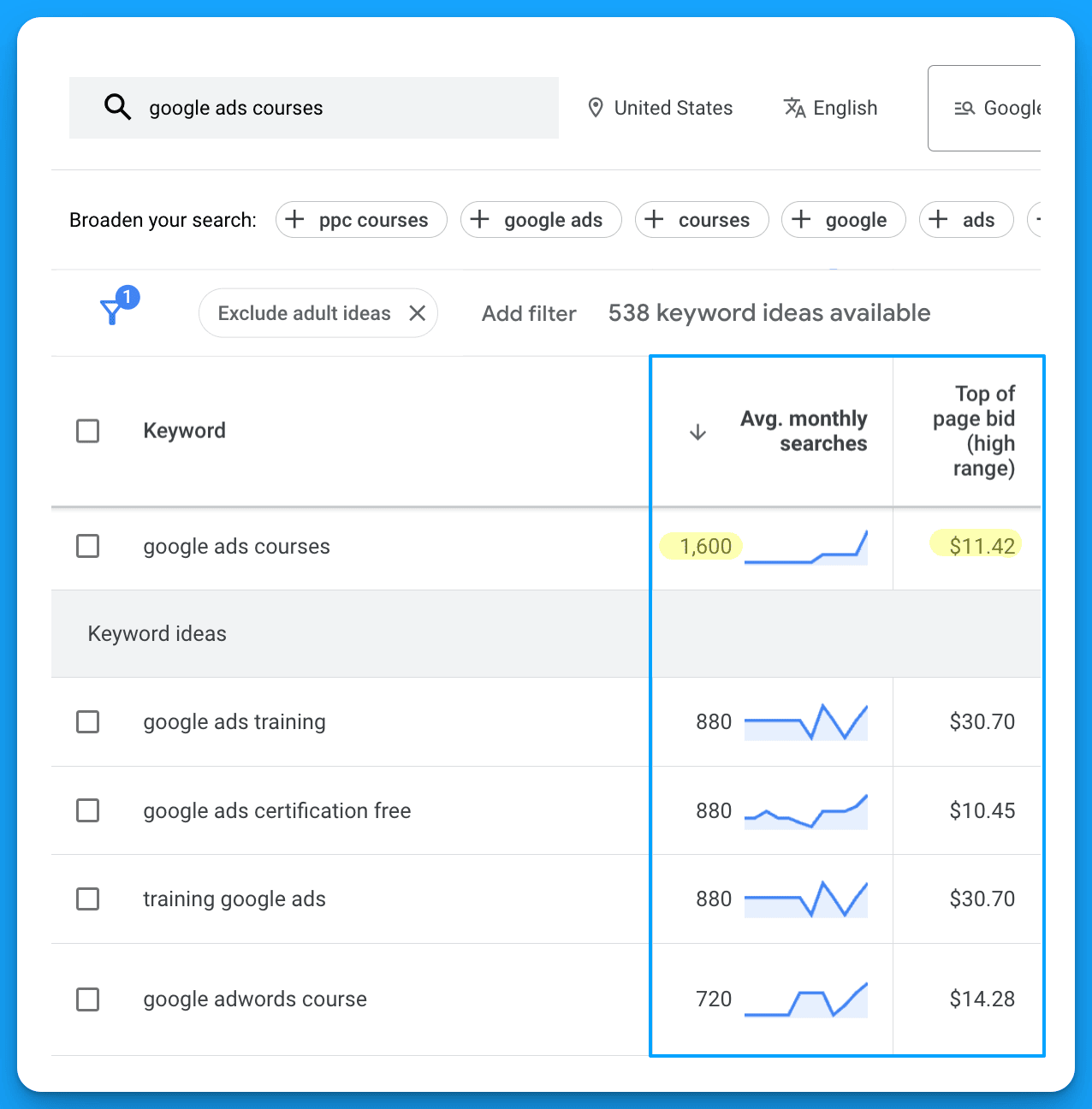
I recommend always using the top of page bid (high range) as your estimate.
I’ve never seen these estimates be 100% accurate and you’ll never know your real CPC until launch.
To account for this margin of error I recommend adding +20% on top of your top of page estimate.
This means in our google ads courses example:
- It would potentially cost me $13.7 per click ($11.42 +20%)
- I can receive up to 1,600 clicks per month in the USA.
Based on these two data points we can assume it’s possible to spend up to $21,920 per month on this keyword ($13.7 * 1,600).
Outside of the return on investment, don’t forget about return on effort.
If your dream keywords have very limited search volume (ex: < 100/month) it might not be worthwhile.
How to forecast a daily, monthly, and quarterly Google Ads budget
Once you know your estimated cost per click you’re ready to put together a forecast.
We’ve created a free Google Ads Budget Calculator tool that you can use to easily plan your daily, monthly, and quarterly budget.
You’re going to need the following information for the forecast:
- Your average cost per click (from the Keyword Planner or real data)
- Your quarterly sales goal
- Your average win rate
- Your average revenue per sale
With all this information at hand you’ll plug these different values into the calculator.
Based on your landing page conversion rates you can model a worst, moderate, and best case.
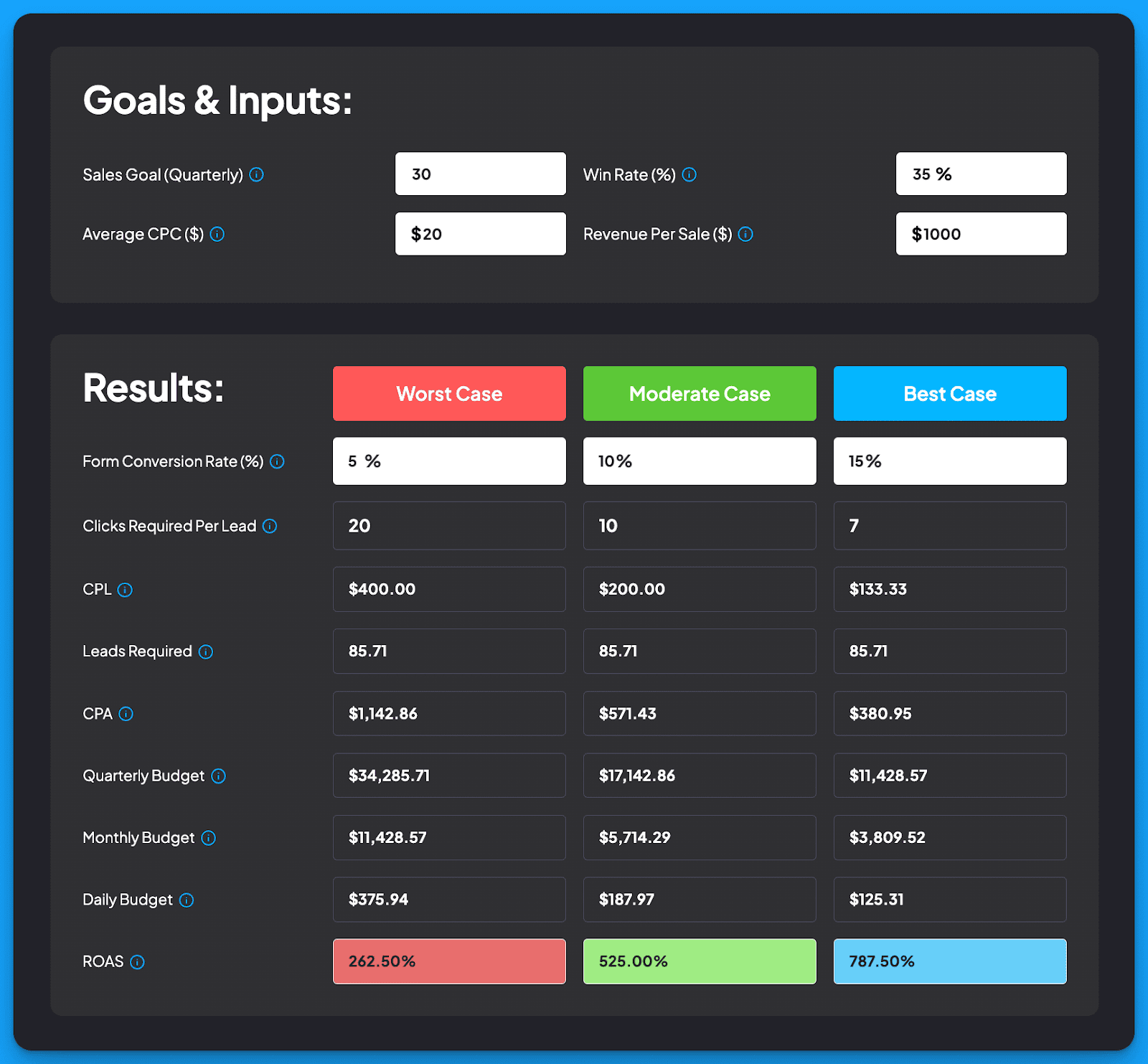
From here you can see how much it will cost to acquire a customer and the budget required to hit your sales volume target.
I highly recommend paying attention to the number of clicks required per lead, this will help frame expectations on how much traffic you’ll need and if your search volume is sufficient.
As you’ll see, your landing page effectiveness is essential at reducing costs 💥
With this forecast at hand you’ll know exactly how much to invest.
How to allocate Google Ads budget by campaign strategy
You should be clear on how much you’ll need to invest in your Google Ads campaigns.
Now the next step is to figure out how you’re going to allocate your budget.
In my experience managing Google Ads campaigns for B2B SaaS companies, there are five proven campaign themes to invest in; NonBrand, Brand, Competitive, RLSA, and Content.
Here’s my recommendation on budget allocation by each if you want to maximize volume.
Use all of these as starting points and modify the amounts based on your data/nuances.

NonBrand = 40% of total budget
NonBrand campaigns are where you’re bidding on high-intent keywords that don’t include your brand, for example google ads courses would be non brand for us at AdConversion.
Think about your keywords you’d like to cover that problem aware prospects would search for.
NonBrand keywords typically contain high-intent modifiers such as:
- Software
- Platform
- Tool
- Technology
- Solution
If you have enough search volume on non brand keywords there’s no easier way to drive conversions than showing up for people looking for solutions to their problems.
Brand = 20% of total budget
Brand campaigns are commonly referred to as “defense” campaigns where you’re bidding on your own brand name to outrank competitors bidding on yours.
You can make the case that people searching your branded terms would convert anyways and it’s not worth the investment.
This is why I recommend no more than 20% of the total budget on this campaign initially.
I’ve seen exceptions here with some of our clients where they saw net new revenue decline significantly from pausing their branded campaigns.
Let your data guide your allocation.
Competitive = 25% of total budget
Competitive campaigns are the opposite of brand where you’re bidding on competitors' names to appear for their existing customers and prospects.
These campaigns can be really hit or miss depending on your execution.
Make sure you’re doing it in a classy way and have dedicated comparison pages.
This theme can be really powerful at driving qualified traffic as these searchers are solution aware.
RLSA = 10% of total budget
RLSA stands for remarketing list for search ads.
This just means search remarketing, anyone that searches your keywords AND is part of an audience.
For example, anyone that has been to your site in the past 90 days and is searching your keywords.
RLSA campaigns can be really powerful when you have enough site traffic and are dealing in competitive niches.
Depending on your available remarketing audience sizes you can decide if this makes sense initially.
Given the limitation of size we typically only allocate 10% here to begin.
Content = 5% of total budget
Content campaigns are great for supporting SEO efforts.
If you have certain keywords you’re struggling to rank for, content campaigns are worth investigating.
This is where you’re going to bid on longtail content related keywords that typically have much lower cost per click prices and drive that traffic to a blog or relevant content piece.
Depending on your content strategy I’d give this some consideration.
Hope you found this article helpful! and now know how to create a winning Google Ads budget strategy.
Frequently asked Google Ads budget questions
Does Google Ads work on a small budget?
Yes, and no. Small is relative to your average cost per click prices.
I’d recommend being able to afford at least 100 clicks per month.
Does Google Ads work for B2B SaaS?
Absolutely, intent is what makes Google Ads so powerful.
The biggest challenge for B2B SaaS is scale.
What is a good Google Ads budget?
A Google Ads budget is one where you can support your business objectives.
Using the following information you can create a forecast to understand what is good:
- Your average cost per click
- Your quarterly sales goal
- Your average win rate
- Your average revenue per sale
From Clicks to Conversions: Master Google Ads for B2B 🔥
If you want to become a Google Ads pro, check out our free B2B Google Ads courses, where you'll learn how to launch, optimize, and scale your campaigns to drive pipeline and revenue.

Here's what you'll learn in each course:
⚙️ B2B Google Ads 101 - How to Launch Dangerously Effective Campaigns for Beginners
- The Googleverse: The Game You're Playing & How To Win
- Measurement: How to Make Sure You're Profitable
- Targeting: How to Show Up For the Right Searcher
- Planning: Putting It All Together
🎯 Google Ads 102 - How to Clicks Into Profit
- Visibility: How To Find the Hole Sucking Profits
- Workflows: How to Optimize On a Daily, Weekly, Monthly & Quarterly Basis
- Experimentation: How to Test & Automate Profitability
- Troubleshooting: How To Solve Inevitable Problems
🚀 Google Ads 103 - How to Scale Google Ads For Advanced Advertisers
- Methodology: How to Vertically Scale Google Ads From A-Z
- Campaigns: Scaling Horizontally Through Campaign Themes
- Channels: Scaling Outside of Paid Search
Click Here to Join 1,000+ B2B Marketers Today and start leveling up your advertising skill set.
Takes < 90 seconds to sign up (seriously we timed it 😂)
.png)
Intro to B2B Google Ads: Crash Course For New Advertisers
Want to master Google Ads for B2B?
We’ll dissect Google Ads from a 10,000 foot view in this guide.
So you can walk away knowing:
- What is Google Ads?
- Is your ideal B2B buyer searching on Google?
- How can you get your ad seen on the top of Google?
- How much does Google Ads cost?
So whether you’re a SaaS founder, performance marketer, or in-house marketer looking to:
- Scale demo and trial requests for your new B2B SaaS startup
- Run Google ads for clients or launch campaigns internally
- Work with freelancers or agencies running your Google Ads
It all starts here with the fundamentals, so let’s dive in! 👇
TABLE OF CONTENTS
- What is Google Ads?
- Is Your Ideal B2B Buyer Searching on Google?
- How Much Does Google Ads Cost?
- How to Forecast Your Google Ads Budget
- Why is Google Ads So Powerful?
- How Can You Get Your Ad Seen on the Top of Google?
What is Google Ads?
Google Ads is an auction place.
Or as I like to think about it, a battleground.
Where you have thousands of advertisers competing against each other to show up on the top of Google when their ideal prospect searches for their products & services.
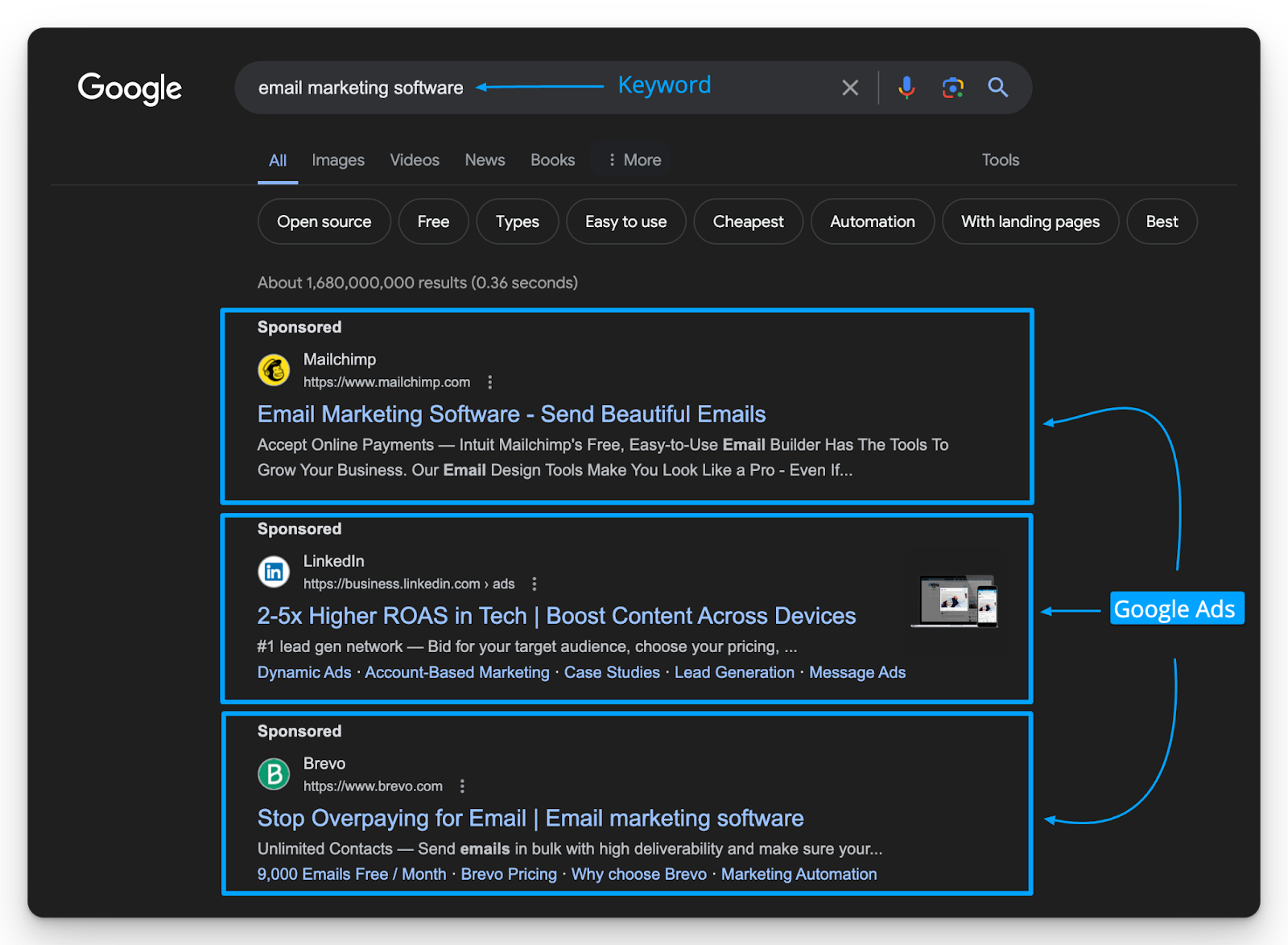
With 8.5B + searchers happening per day on Google there is a very HIGH likelihood your ideal B2B buyer is using Google to find information, and research solutions.
Is Your Ideal B2B Buyer Searching on Google?
Depending on the niche you’re in Google may or may not make sense.
You can create a free Google Ads account and leverage the Keyword Planner to validate demand.
All you need to do is research the ideal keyword your dream buyer would search and review the average monthly search volume and top of page bid estimates.
In the example below, I can see that for “email marketing software” there is:
- 1,000 - 10,000 average monthly searches
- $49.75 top of page bid estimate
If your ideal keyword has > 100 searches per month, Google can be a worthwhile return on effort.
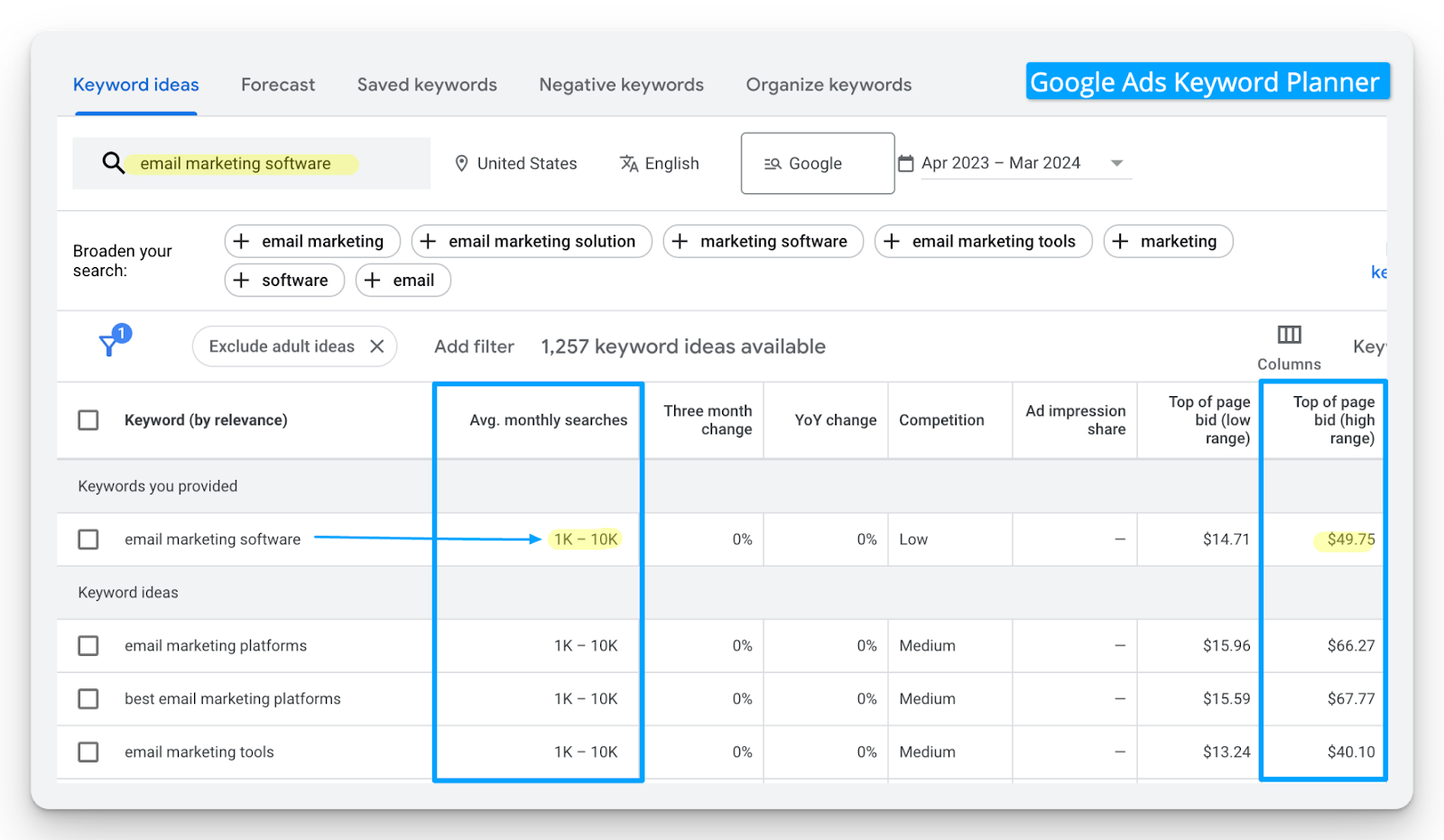
How Much Does Google Ads Cost?
Before diving into how much does Google Ads cost?
With Google Ads you’re only charged on a cost-per-click (CPC) basis.
Meaning you only pay Google if someone clicks your ad, so unlike traditional advertising you’re not being locked into a fixed contract and paying just for eyeballs (aka impressions).
So in short if someone sees your Google Ad and doesn’t click, you won’t pay.
This is what makes Google Ads so attractive, but extremely competitive.
Here’s two ways to find out how much Google Ads will cost for your ideal keywords:
1/ Review Top of Page Bid Estimates in the Google Ads Keyword Planner
As shown in the previous step you can leverage the Keyword Planner to find bid estimates.
In my experience these estimates are never 100% accurate and recommend adding 20% on top of the top of page bid estimate to be safe.
For example, with the keyword of email marketing software we have a $49.75 top of page bid estimate, adding 20% makes it $59.70 allowing us a margin of error to better set expectations.
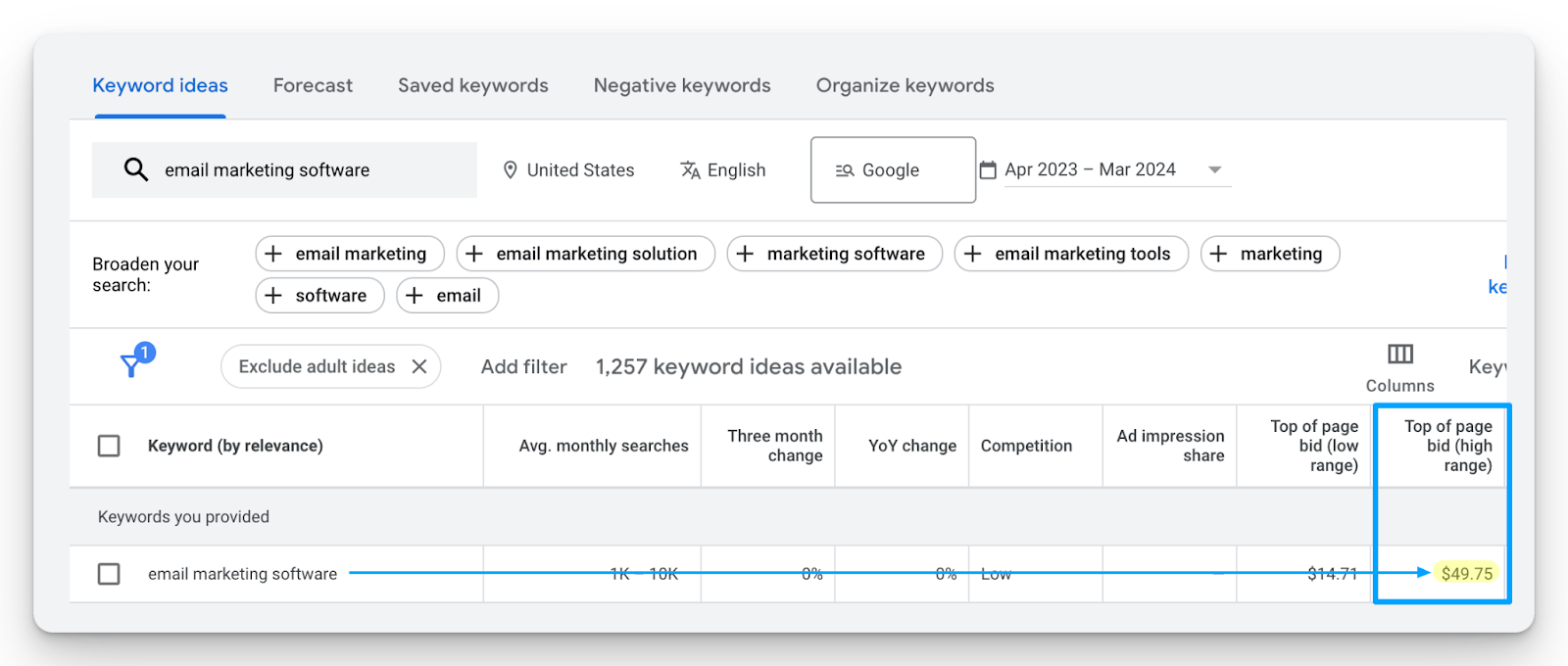
2/ Launch a Pilot Campaign for $100
Ultimately you’ll never know your real cost per click prices until launching.
If you’re seriously considering Google Ads I recommend launching a pilot campaign for $100.
The whole objective of this campaign is to understand; what is my REAL cost per click price?
Here’s a simple cheat sheet for setting up this campaign:
- Campaign Name = {Region}_{KeywordTheme}_{MatchType}
- Locations = {Your Target Country/Region/State}
- Match Type = Exact
- Bidding = Manual CPC
This setup will allow you to have the greatest control to discover your real CPC prices.
How to Forecast Your Google Ads Budget
Once you know the following:
- Your quarterly sales goal
- Average cost per click
- Opportunity win rate
- Revenue per sale
You can easily forecast a daily, monthly, and quarterly budget using our Google Ads Budget Calculator based on worst, moderate, and best case scenarios.
Give it a look, there’s a video tutorial on the page for you explaining the process.

Why is Google Ads So Powerful?
Intention Is what makes search advertising so powerful 🤝
You can reach exactly the right person, in the right place, in the right location searching for your specific product or service. At that point all you have to do is show up and not mess things up.
I always say Google Ads is a blessing and a curse; they bless you with intent, and curse you with scale.
Given your industry search volume will vary dramatically and it can become hard to scale.
The key is to win Google’s Ad Rank game to offset competitors and rising click prices.
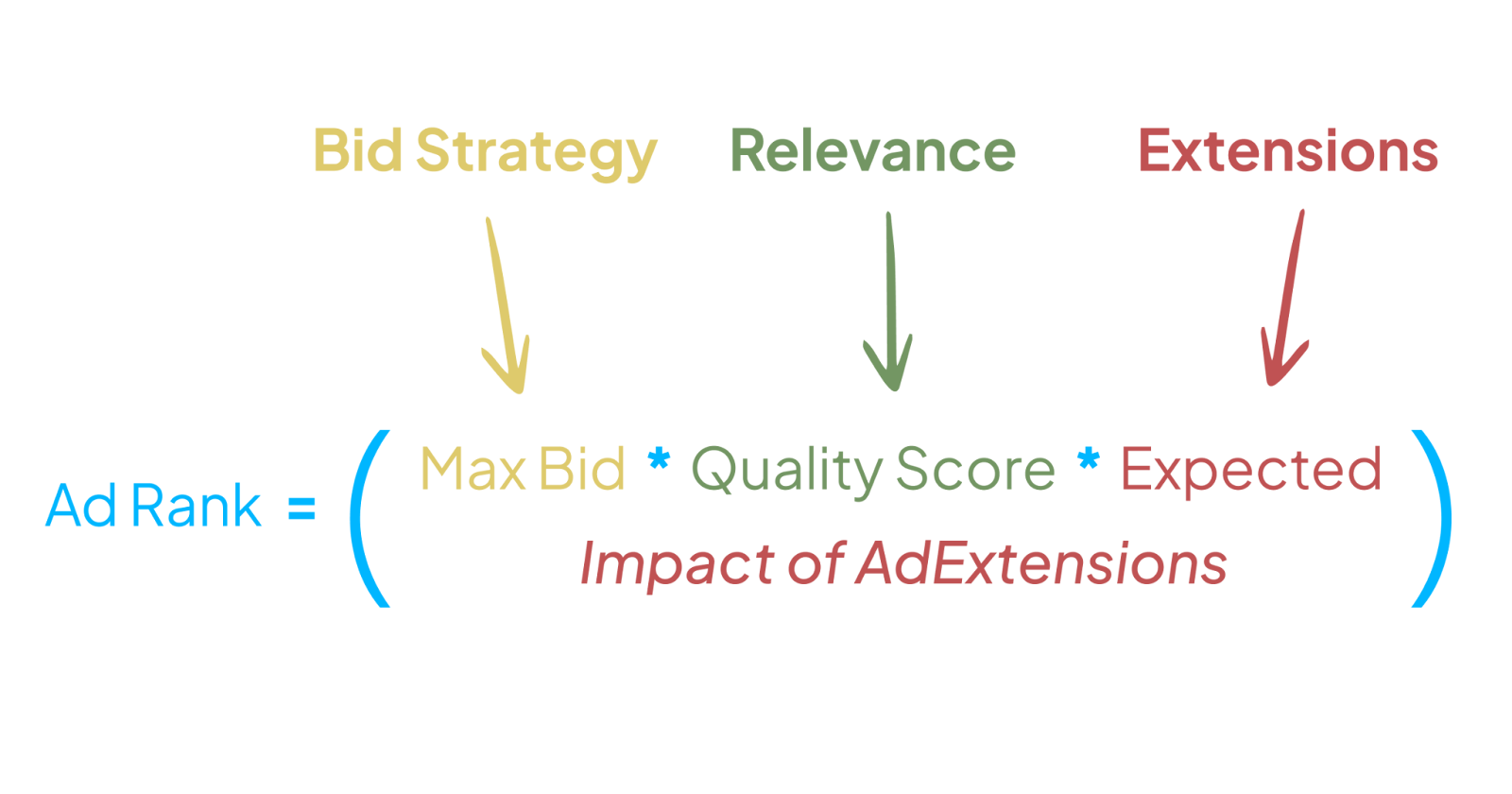
How Can You Get Your Ad Seen on the Top of Google?
Every time you search for something on Google (or other search engines such as Yahoo, Bing, and Firefox) the results page you’re directed to afterwards is the Search Engine Results Page (SERP).
I like to think of the SERP as the Battleground in which Google Ads takes place.
The SERP is Divided Between Paid and Organic Results.
The Google SERP usually has about 3-4 paid ads at the top and 3 at the bottom.

Ad Rank Determines the Position of Your Ad on the First Page
Which determines if your ad is on top of the first page of or nowhere to be seen.
Your goal is to appear in the top 3 spots as click-through rates decline with lower positions.
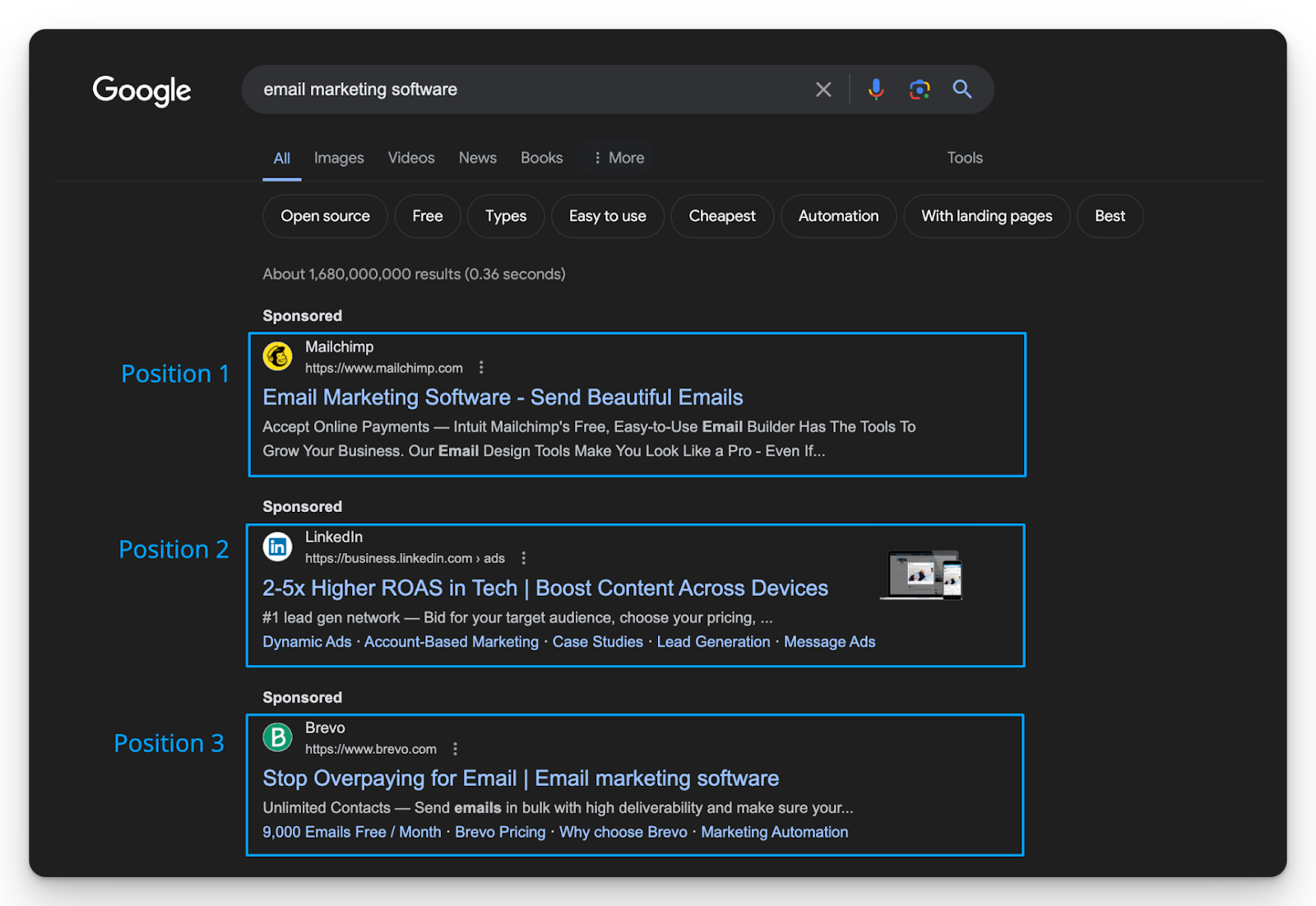
Higher Position Doesn't Always Mean Greater Cost
The remarkable thing about Google Ads is that you can be #1 on the page and pay less than your competitors who are in positions lower than you (hypothetical example below).
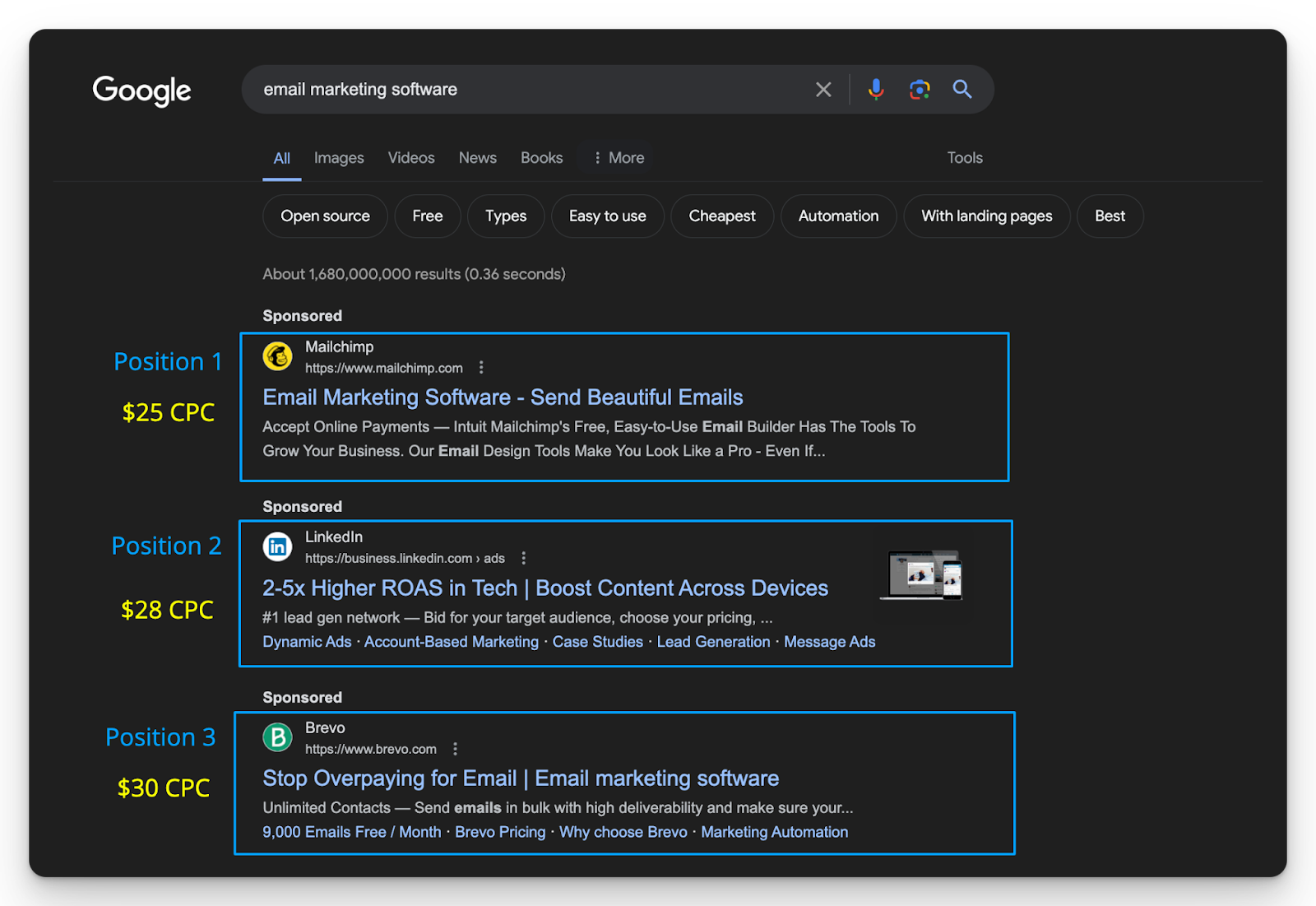
If after reading this article you believe Google Ads is worth further exploration.
Build on this fundamental understanding of Google Ads for B2B.
Hope you found this useful!
From Clicks to Conversions: Master Google Ads for B2B 🔥
If you want to become a Google Ads pro, check out our free B2B Google Ads courses, where you'll learn how to launch, optimize, and scale your campaigns to drive pipeline and revenue.

Here's what you'll learn in each course:
⚙️ B2B Google Ads 101 - How to Launch Dangerously Effective Campaigns for Beginners
- The Googleverse: The Game You're Playing & How To Win
- Measurement: How to Make Sure You're Profitable
- Targeting: How to Show Up For the Right Searcher
- Planning: Putting It All Together
🎯 Google Ads 102 - How to Clicks Into Profit
- Visibility: How To Find the Hole Sucking Profits
- Workflows: How to Optimize On a Daily, Weekly, Monthly & Quarterly Basis
- Experimentation: How to Test & Automate Profitability
- Troubleshooting: How To Solve Inevitable Problems
🚀 Google Ads 103 - How to Scale Google Ads For Advanced Advertisers
- Methodology: How to Vertically Scale Google Ads From A-Z
- Campaigns: Scaling Horizontally Through Campaign Themes
- Channels: Scaling Outside of Paid Search
Click Here to Join 1,000+ B2B Marketers Today and start leveling up your advertising skill set.
Takes < 90 seconds to sign up (seriously we timed it 😂)
People Also Ask
How can I effectively integrate Google Ads into my existing B2B marketing strategy?
Align your Google Ads campaigns with your overall marketing objectives by ensuring consistent messaging across all channels. Coordinate with sales and marketing teams to create cohesive campaigns that guide prospects through the sales funnel.
What are the best practices for managing budgets in B2B Google Ads campaigns?
Regularly monitor and adjust your budget allocation based on campaign performance. Prioritize spending on high-performing keywords and ads, and consider implementing bid strategies that align with your goals, such as target CPA or ROAS.
How can I leverage Google’s audience targeting features for B2B advertising?
Utilize features like custom intent audiences to reach users actively searching for products or services similar to yours. Combine this with demographic targeting to focus on decision-makers within your target industries.
What role does ad scheduling play in optimizing B2B Google Ads campaigns?
Implement ad scheduling (dayparting) to display your ads during times when your target audience is most active. This ensures efficient budget use and increases the likelihood of engagement during peak business hours.
How can I ensure compliance with Google’s advertising policies in B2B campaigns?
Regularly review Google’s advertising policies to ensure your ads meet all guidelines. This includes adhering to content standards, avoiding prohibited practices, and ensuring transparency in your ad copy and landing pages.
.png)
Beginner’s Guide to Google Ads Competitor Analysis In 2024
Looking to research competitor's Google Ads?
In this guide I'll walk you through how to find their best ads, and reverse engineer their strategy.
Regardless of if your budget is as low as $10/day or $10,000/day, the same process applies.
We’ll first focus on analysis in this guide and then dive into strategy.
Let’s get into it! 👇
TABLE OF CONTENTS
- How to Find & Research Competitors Google Ads
- Free Tools to Find Examples of Competitors Google Ads
- Paid Tools to Find Examples of Competitors Google Ads
- How to Break Down Your Competitors Google Ads Strategy
How to Find & Research Competitors Google Ads
Pablo Picasso once said “good artists copy, and great artists steal” taking inspiration from what works from your competitors and transforming it into “your own” way is a sound approach.
Just remember this can sometimes lead to a situation where everyone is copying each other and no one has any real idea of what their doing in the first place 😅
Ultimately beating your own baseline performance is what you should obsess about.
With this disclaimer out of the way, you first need to know what competitors you want to research.
You can find who you’re up against with the auction insights report in Google Ads.

Find this report by navigating to Keywords > Auction Insights within your Google Ads account.
- Sort this report by Impression Share to understand how visible you are against your competitors for your targeting criteria (ex: keywords, locations, audiences).
- Review the Top of page rate as well to understand how often you and your competitors appear within the top 3 positions of Google.
Now that you have an understanding of who your competitors are.
Let’s dive into the free and paid tools you can use to conduct Google Ads competitor analysis.
Free Tools to Find Examples of Competitors Google Ads
Each of the following competitor analysis tools can be used for free, leverage whichever resonates.
Google Ads Transparency Center
Source: https://adstransparency.google.com/
The Google Ads Transparency Center was released on March 29, 2023 as a way to help you quickly and easily learn more about the ads you see on Search, YouTube and Display.
Since the release of this tool it’s become an absolute goldmine for Google advertisers.
Here’s how you can leverage the Google Ads Transparency Center for competitor analysis:
1. Visit the Google Ads Transparency Center and enter your competitors domain URL

2. Scroll down to see the most recent Search, YouTube, and Display ads
.gif)
When scrolling through the results take note of the following:
- Number of total ads to understand how active your competitor is.
- The language the ads are written in to know if your competitor is running localization strategy.
- The primary keyword your competitor is trying to target in the ad copy.
- {Parameters} in the ad copy to know if your competitor is using dynamic search ads or keyword insertion.
3. Once you find an interesting ad click on it to reveal the target location
- Click on the show anywhere button to reveal the target location for the ad.

Armed with this information you can decide if you want to advertise to these same regions.
If you only used 1 tool for Google Ads competitor analysis I’d recommend the Transparency Center.
ISearchFrom
Source: https://isearchfrom.com/
If you’re planning to advertise somewhere you’re not physically located and want to know which competitors are bidding on your target keywords, ISearchFrom is a great free tool to use.
Here’s how you can utilize ISearchFrom for google ads competitor analysis:
1. Visit ISearchFrom and enter your target country and keyword
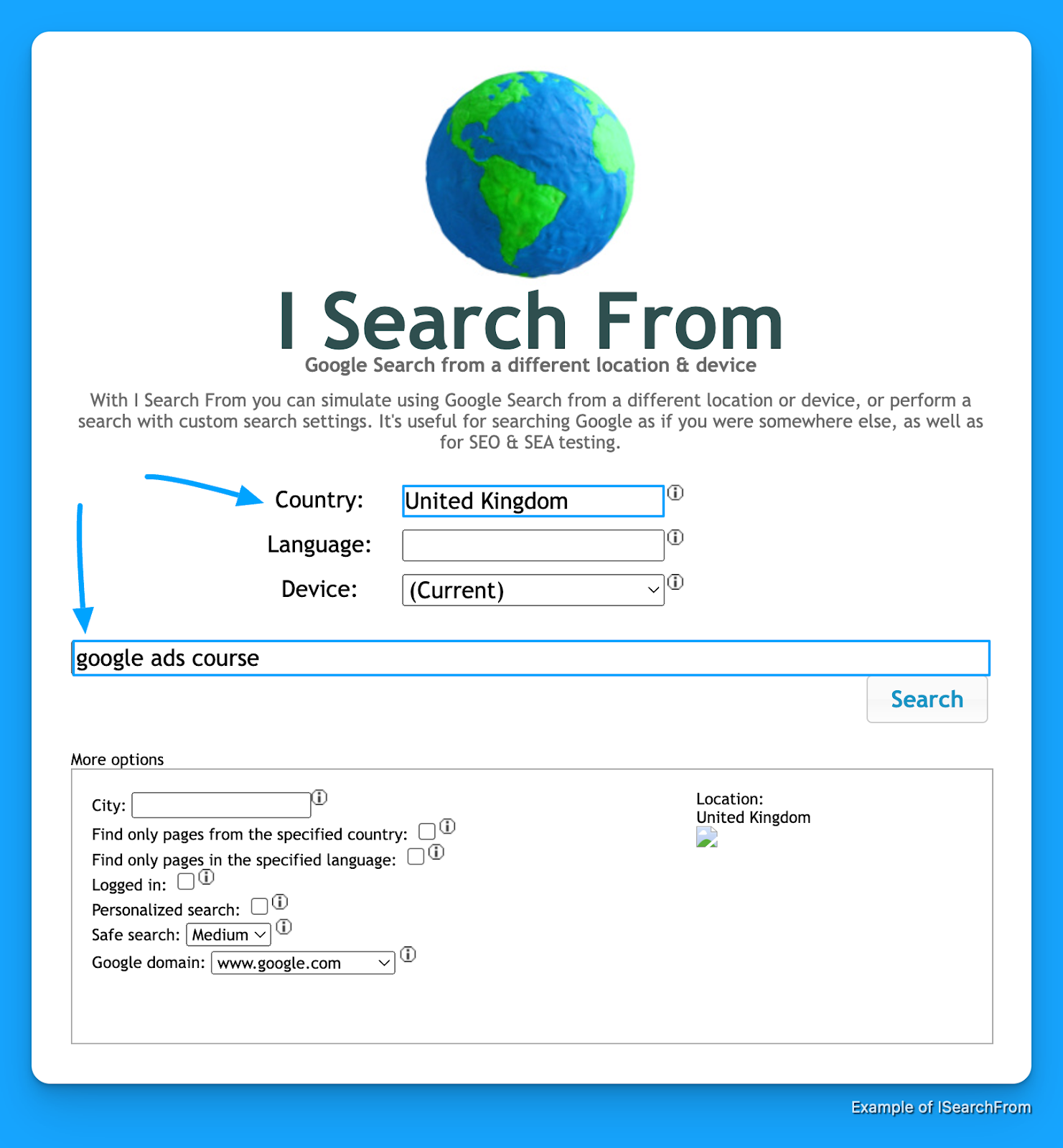
2. Review the ads to uncover advertisers in your target location you might not be aware of

From this simulated result for someone “physically” located in the United Kingdom I can see Coursera is advertising on google ads courses in this region.
From here I can leverage the Transparency Center to uncover more ad examples from them.
Again this is a great tool for finding competitors you’re not familiar with in locations you’re not in.
Paid Tools to Find Examples of Competitors Google Ads
Each of the following competitor analysis tools can be used for a fee, use whichever resonates and fits your budget.
SpyFu
Source: https://www.spyfu.com/
Price: $39-$79/month
If you’re looking for a simple tool to review examples of competitors Google Ads copy, target keywords, and landing pages.
SpyFu is a great tool to start off with, here’s how you can use it.
1. Visit SpyFu and enter your competitors domain

2. Review your competitors estimated Google Ads budget and quantity of paid keywords
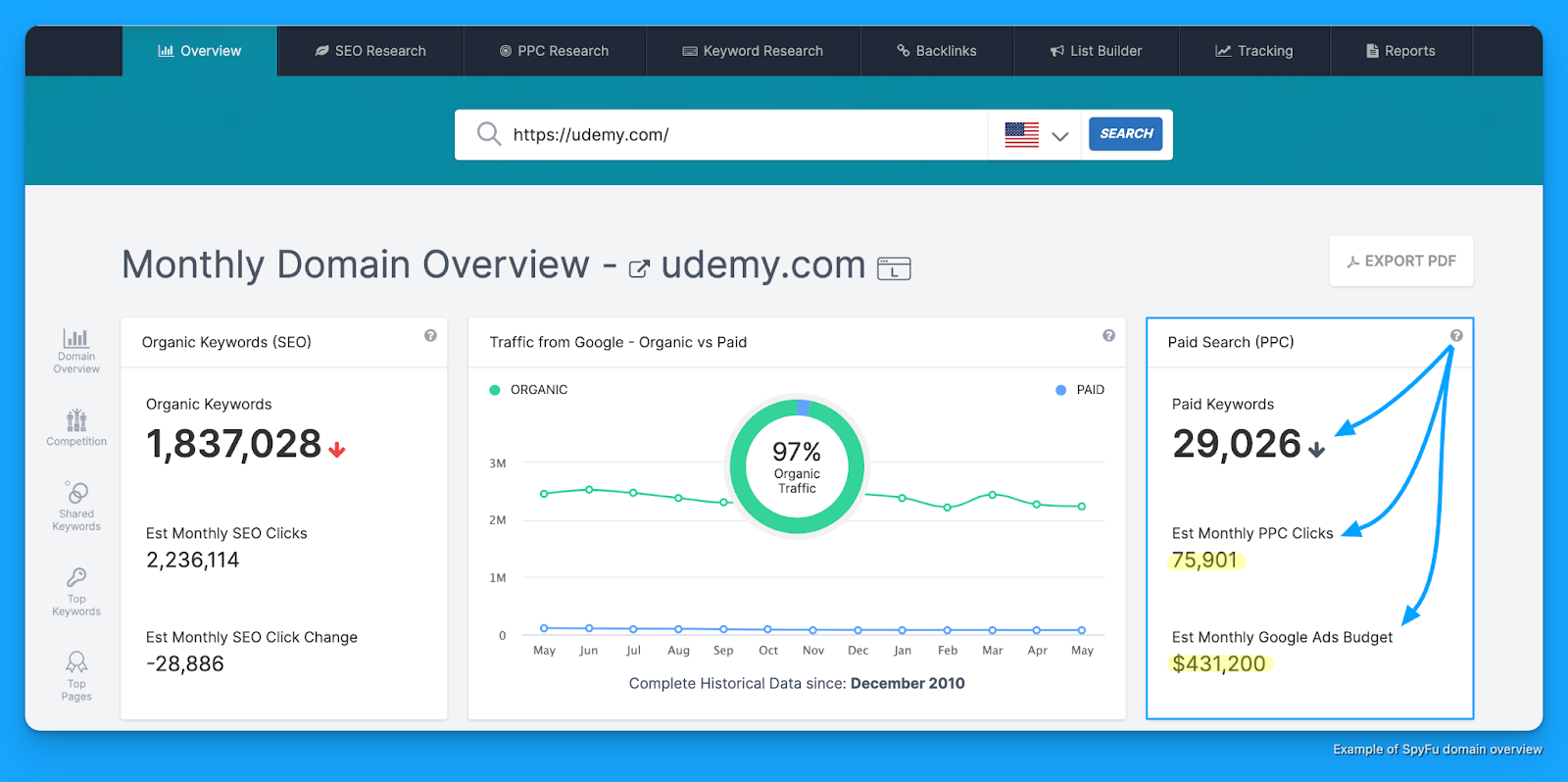
3. Navigate to “PPC Research > PPC Keywords” to see all paid keywords
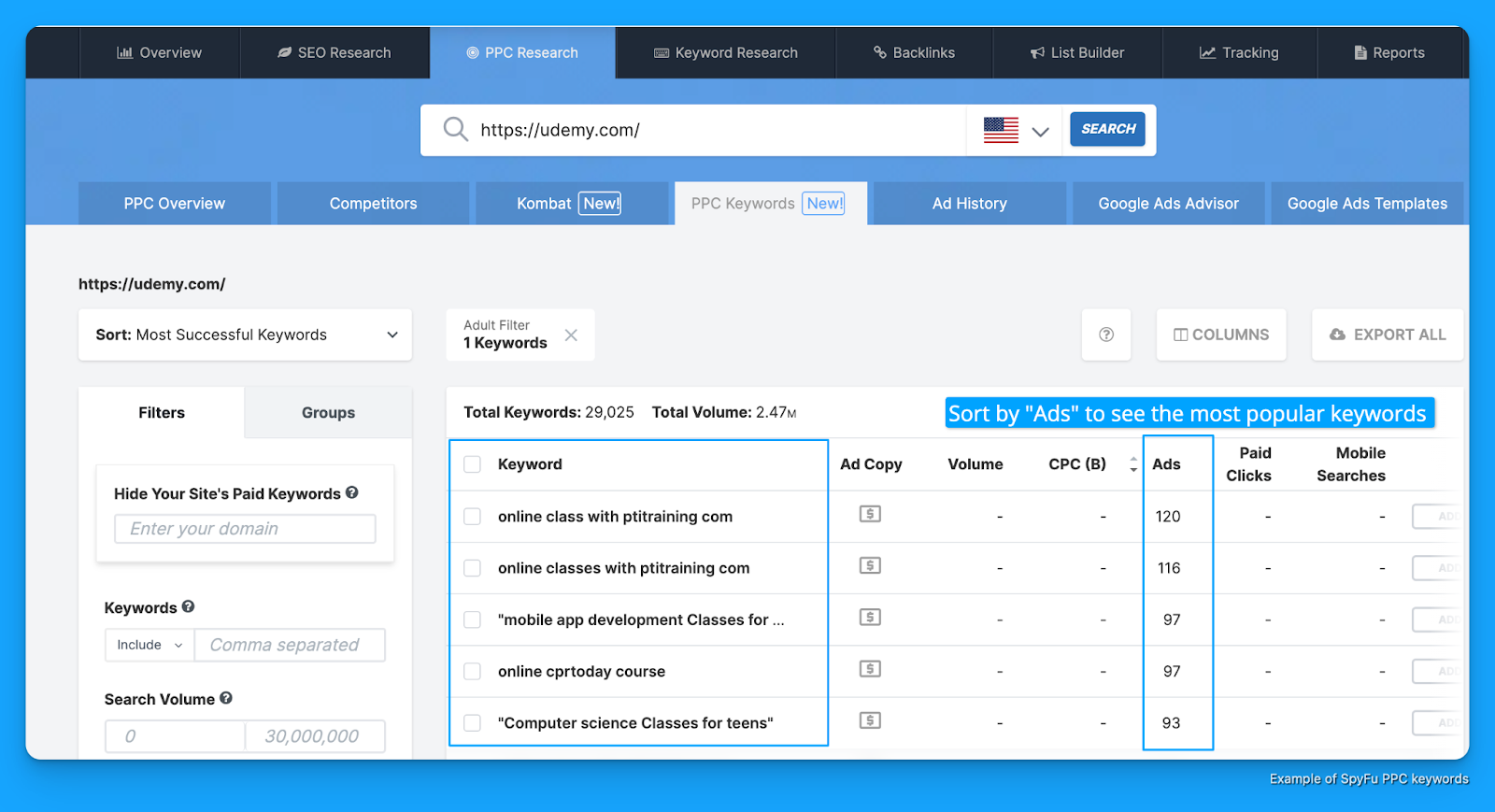
4. Head to “PPC Research > Ad History” to see all competitor ad examples by keyword
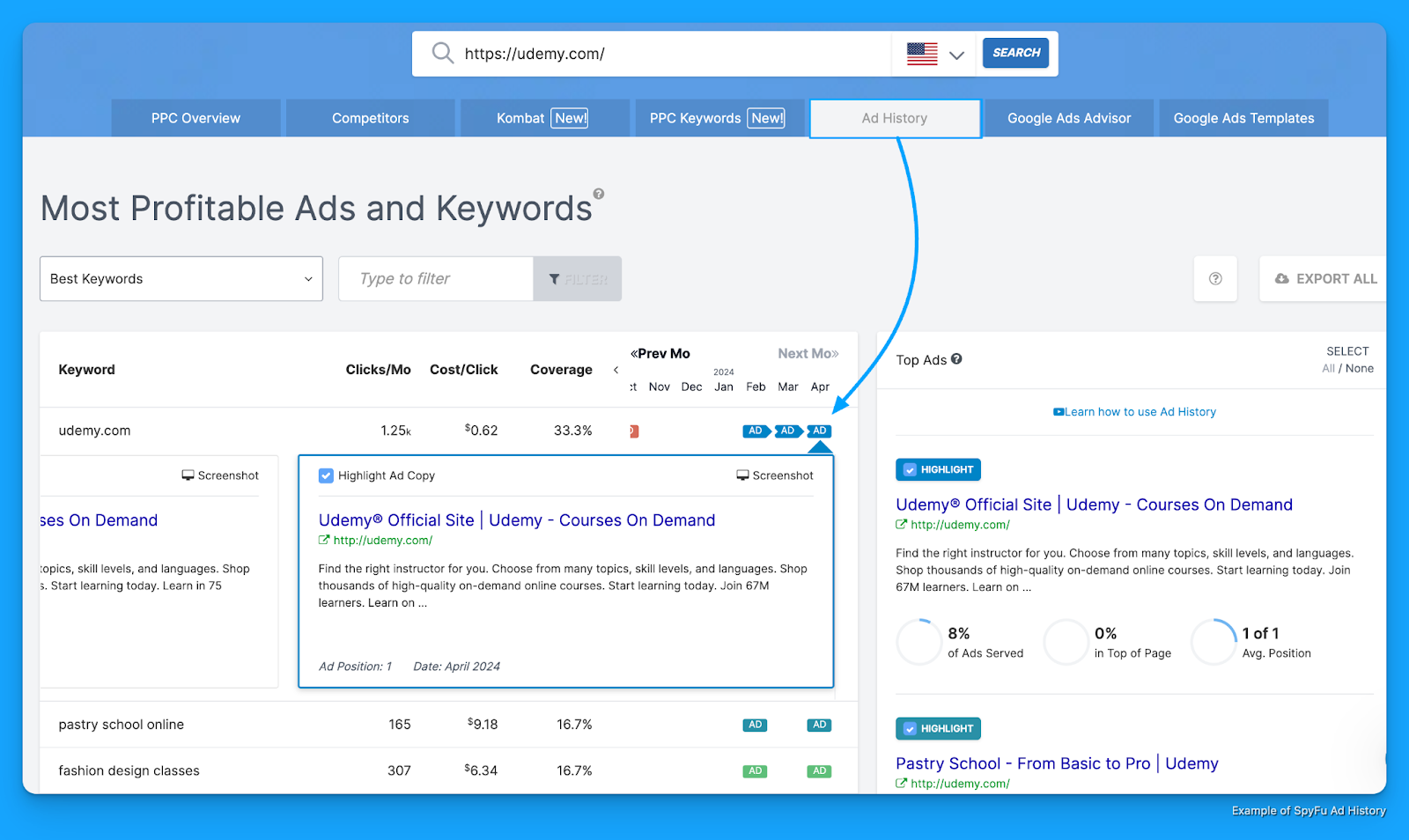
5. Uncover other top competitors “PPC Research > Competitors” you might know of
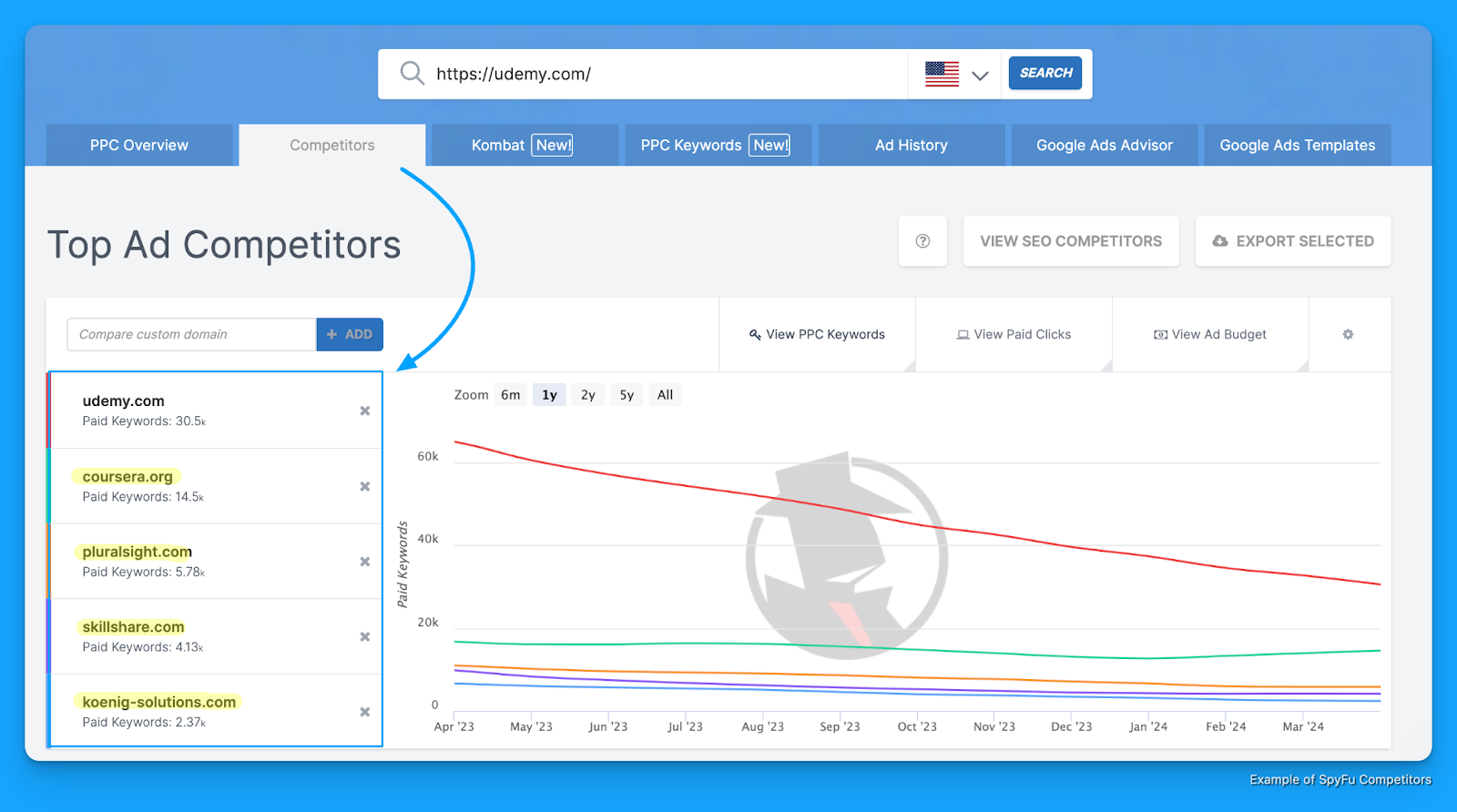
With this one tool you can get estimates of competitors' Google Ads budgets, review keywords, ads, and uncover opportunities across new competitors you might not know of.
Other paid tools:
There’s no shortage of paid tools you can use to research your competitors.
Here’s a list of some others worth exploring:
Don’t get hung up on the tools.
Achieving the end outcome is ultimately key.
Now that you know how to find and research your competitors Google Ads.
Let’s walk through how to break down their strategy.
How to Break Down Your Competitors Google Ads Strategy
Knowing what keywords and ad copy your competitors are using is a great starting point.
But getting answers to questions like:
- How are my competitors structuring their campaigns?
- How are they allocating budget?
are crucial insights that can separate you from them.
1. Reverse Engineering URL Parameters
Once you know your competitors landing pages, which you can get from:
- Searching keywords in Google and clicking on their ads
- Reviewing landing page URLs in SpyFu’s Ad History report
You’ll want to review their UTM parameters to get insights on the goal of this campaign, target keyword, and anything else around how it was set up.
URL Parameter Example #1 - Zoho
For example, I searched CRM software and clicked on this ad from Zoho:
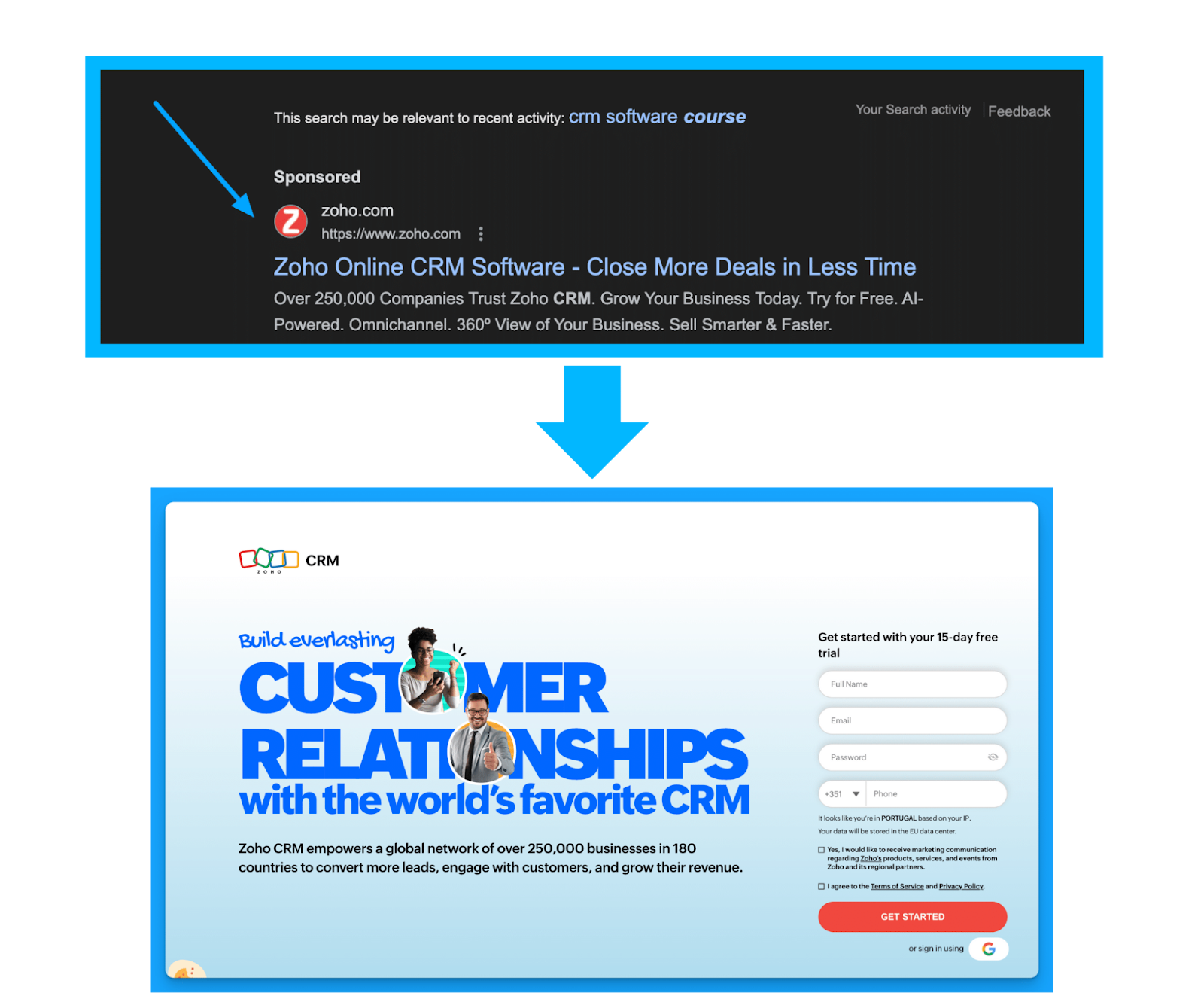
When reviewing the URL post click I can see the following parameters:
/?network=g&device=c&keyword=crm%20software&campaignid=14928929712
&creative=552506800726&matchtype=e
&adposition=&placement=&adgroup=130022006802&gad_source=1
&gclid=Cj0KCQjw3tCyBhDBARIsAEY0XNlAKXey
TKDzEJQDpeNh2giI4p8sVSnWKqsvlND5bvZa_J
q62wCqSFoaAsc1EALw_wcB
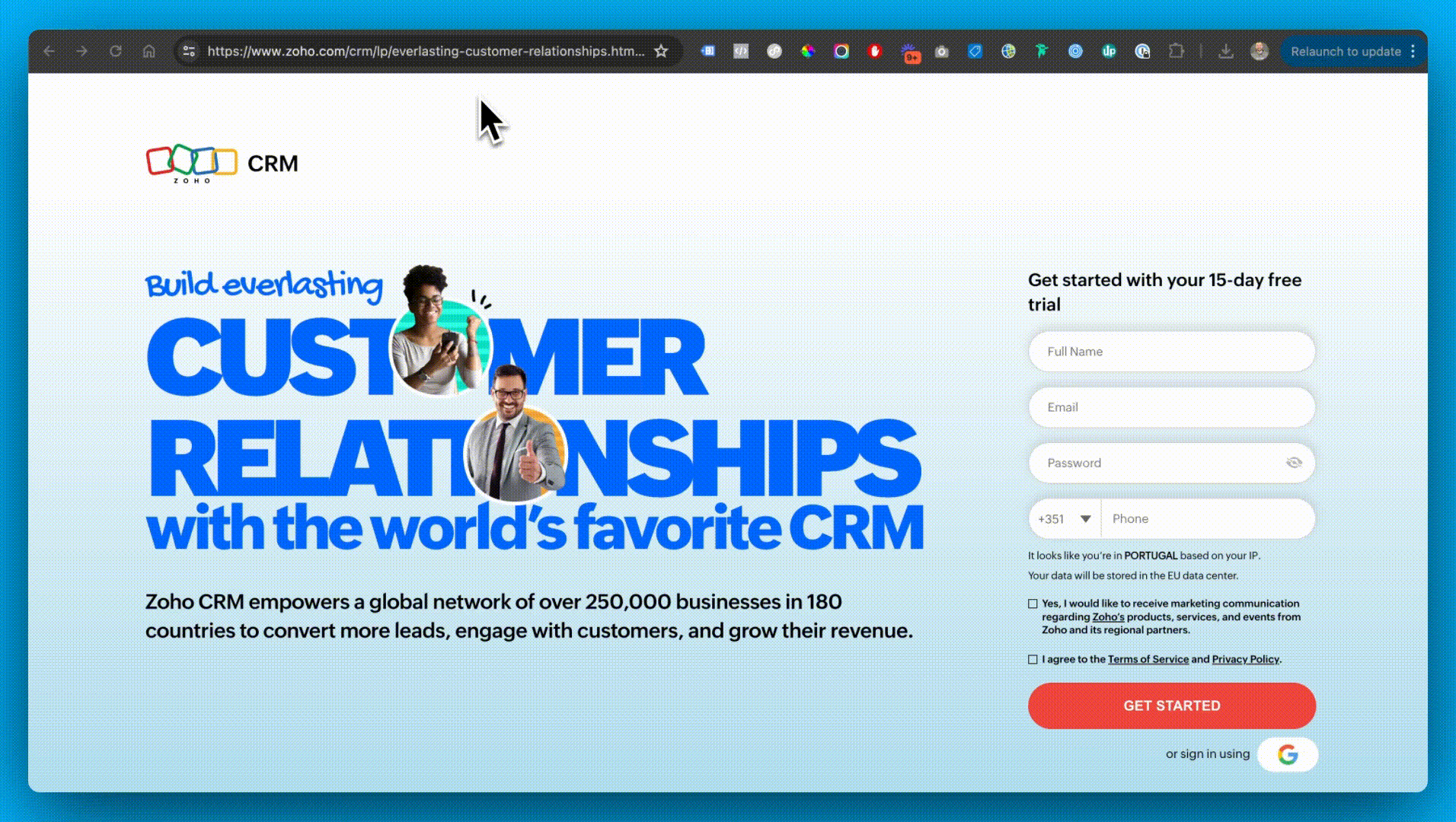
By reviewing the URL structure I can gather the following information:
- Network = g | they’re advertising on Google Search
- Device = c | they’re running ads on Desktop devices
- Keyword = crm software | they’re bidding on crm software
- Matchtype = e | they’re using exact match
URL Parameter Example #2 - Freshworks
Let’s use one more example to drive this home with the Freshworks ad that was underneath Zoho:
?tactic_id=6071454&utm_source=google-adwords&utm_medium=FSales-Search-InsideEU-FSE-RLSA-New
&utm_campaign=FSales-Search-InsideEU-FSE-RLSA New&utm_term=crm%20software&device=c
&matchtype=p&network=g
&gclid=Cj0KCQjw3tCyBhDBARIsAEY0XNkaG_AiGqCRYj-AEcuQcnvJS_3eI0bS6jIKu_
M7JRmqOYwSIGwuc6UaAvYqEALw_wcB&gad_source=1
Here’s what I’m able to gather from the URL structure:
- Source = google-adwords | they’re advertising on Google Search
- Campaign = FSales-Search-InsideEU-FSE-RLSA-New | they’re advertising in the EU and running a remarketing list for search ads campaigns.
- Term = crm software | they’re advertising on the keyword crm software
- Device = c | they’re bidding on desktop devices
- Matchtype = p | they’re using phrase match
With this information you can start to get answers into how your competitors are structuring their campaigns and it’s freely available and ready for those advertisers that are savvy enough to look.
2. Keyword Classification
How are your competitors allocating budget?
Now you’ll never know the answer to this question with absolute certainty but with some manual work here’s how you can try and piece together a sense of their strategy allocation.
You’ll need one of the paid tools listed above in order to perform this keyword analysis.
I’ll be using SEMRush for the sake of demonstration but the general process is the same across tools.
1. Export all of your competitors paid keywords into a CSV

2. Filter the Last Seen column by the most recent month to see active keywords

3. Add a new column called “Theme” and classify each keyword by campaign theme.
This step can take some significant time but can be well worth the effort to understand your competitors keyword strategy and budget allocation priorities.
With your custom column of “campaign theme” you’ll want to manually classify each keyword.
Here’s the four campaign themes you’ll utilize for classification:
- NonBrand = high-intent keywords that don’t include your brand name
- Brand = keywords containing your brand name
- Competitive = keywords that represent your competitors
- Content = keywords that are informational and research oriented
Watch this video for a deep dive on how to perform this advanced classification:
4. Summarize your classified keywords into a pivot table to understand your competitors strategy and budget priorities
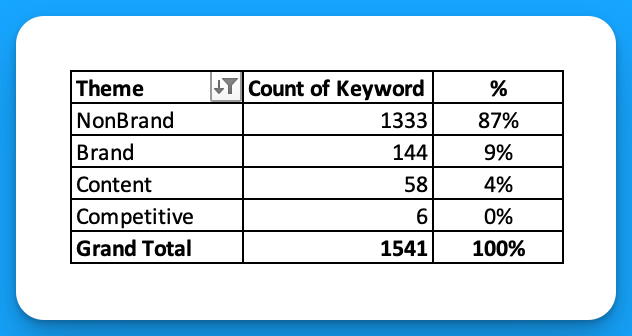
From here we can make some assumptions about what is working for our competitors.
- 87% of Udemy’s keywords are NonBrand, 9% Brand, 4% Content, and barely 0% Competitive.
- It’s safe to assume that the majority of the budget is supporting NonBrand, followed by Brand, Content, and ultimately Competitive.
Based on this allocation I might want to focus on NonBrand first given the volume of investment Udemy seems to be spending on it, and avoid competitive keywords to start.
This isn't 100% exact science but an advanced way to research your competitors Google Ads.
Need help calculating your stating Google Ads Budget?
If you’re in need of help calculating your starting Google Ads budget check out our calculator.
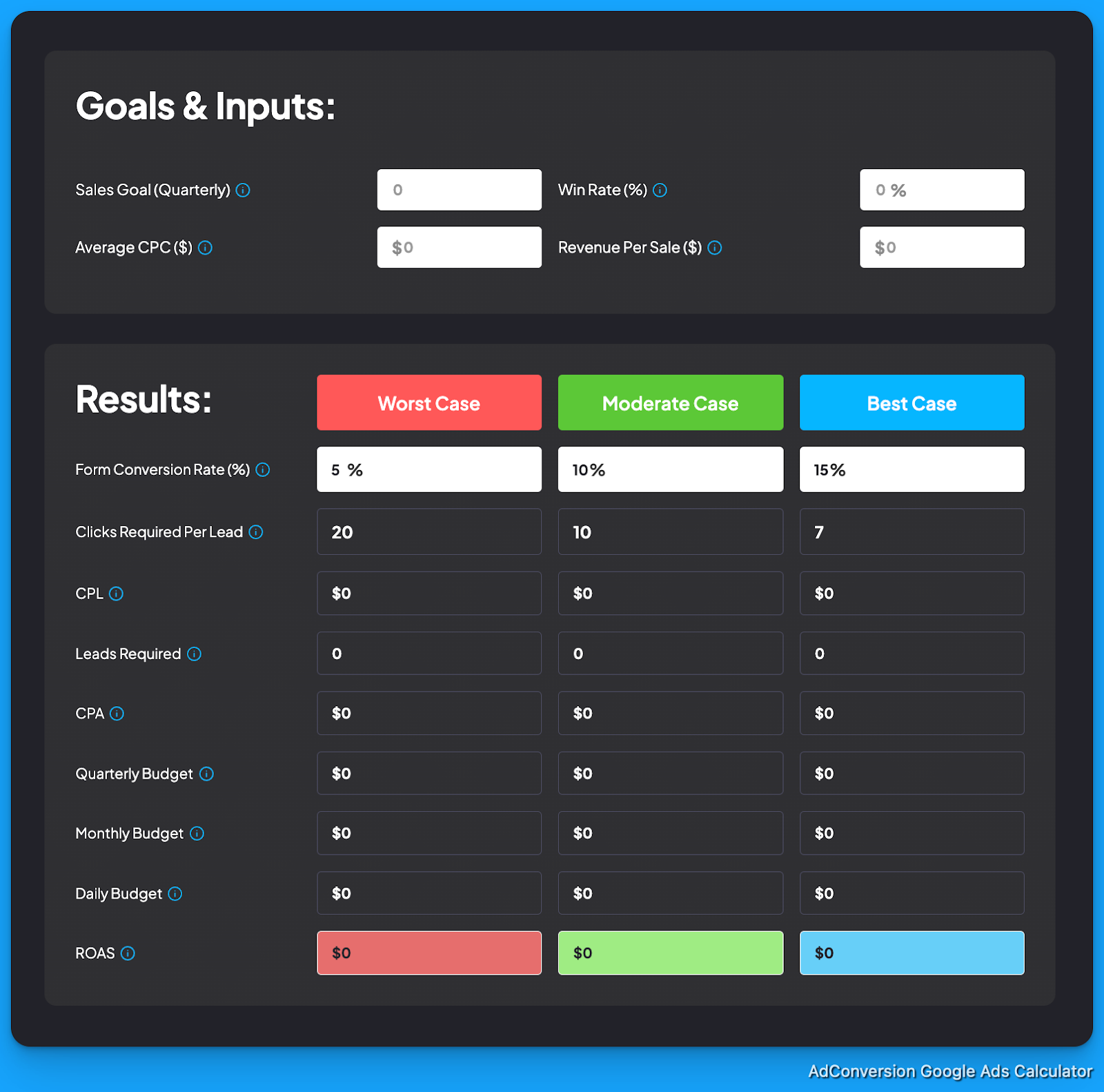
Hope you found this article useful!
See you in the next article or one of our free courses!
From Clicks to Conversions: Master Google Ads for B2B 🔥
If you want to become a Google Ads pro, check out our free B2B Google Ads courses, where you'll learn how to launch, optimize, and scale your campaigns to drive pipeline and revenue.

Here's what you'll learn in each course:
⚙️ B2B Google Ads 101 - How to Launch Dangerously Effective Campaigns for Beginners
- The Googleverse: The Game You're Playing & How To Win
- Measurement: How to Make Sure You're Profitable
- Targeting: How to Show Up For the Right Searcher
- Planning: Putting It All Together
🎯 Google Ads 102 - How to Clicks Into Profit
- Visibility: How To Find the Hole Sucking Profits
- Workflows: How to Optimize On a Daily, Weekly, Monthly & Quarterly Basis
- Experimentation: How to Test & Automate Profitability
- Troubleshooting: How To Solve Inevitable Problems
🚀 Google Ads 103 - How to Scale Google Ads For Advanced Advertisers
- Methodology: How to Vertically Scale Google Ads From A-Z
- Campaigns: Scaling Horizontally Through Campaign Themes
- Channels: Scaling Outside of Paid Search
Click Here to Join 1,000+ B2B Marketers Today and start leveling up your advertising skill set.
Takes < 90 seconds to sign up (seriously we timed it 😂)
People Also Ask
How can I identify indirect competitors in Google Ads?
Beyond direct competitors, consider businesses offering alternative solutions that address the same customer needs. Use tools like Google’s Keyword Planner to discover who is bidding on related keywords, revealing indirect competitors.
What are the ethical considerations when analyzing competitors’ ads?
While it’s acceptable to study competitors’ public ads, avoid deceptive practices like clicking on their ads to deplete budgets. Focus on gathering insights without engaging in unethical behavior.
How often should I conduct a competitor analysis for my Google Ads campaigns?
Regular analysis is crucial. Aim to review competitors’ strategies quarterly to stay informed about market trends and adjust your campaigns accordingly.
Can competitor analysis help in identifying new market opportunities?
Yes, by examining competitors’ ad strategies, you can uncover underserved niches, emerging trends, or gaps in the market, allowing you to capitalize on new opportunities.
How do I ensure my Google Ads stand out in a competitive landscape?
Focus on unique selling propositions, compelling ad copy, and high-quality visuals. Regularly test and optimize your ads to differentiate your offerings from competitors.

3 Powerful Strategies For Scaling SaaS Google Ads You Need To Know
Google Ads is a blessing and a curse.
You're blessed with intent and cursed with scale.
It’s a powerful channel for scaling pipeline for SaaS startups but low search volume is a challenge.
In this article you’re going to learn 3 powerful strategies for scaling your SaaS google ads further.
This won’t solve your limited search volume issues that's just the nature of your target keywords and B2B SaaS but these strategies will help you squeeze more performance from your account.
Let’s dive into it 👇
TABLE OF CONTENTS
- Strategy #1: Broad Match Discovery
- Strategy #2: Advertising outside of English
- Strategy #3: Industry campaigns
Strategy #1: Broad Match Discovery
Before you click away I’m not talking about using broad match in the traditional sense.
Where you let Google show your ads for WHATEVER they think is relevant.
Broad match discovery is where you combine broad match keywords AND an audience.
It essentially means you’re giving Google the flexibility to show your ads for whatever they feel is relevant but within the confines of your targeted audience.
I would not recommend testing this approach unless you have:
- Strong negative keyword lists
- Proven converting phrase match keywords
- Significant conversion volume (> 15/month)
The benefit is you get to scale your top keywords safely past phrase match.
How to implement broad match discovery:
Step 1: Find proven converting phrase match keywords
Review your performance across converting phrase match keywords to identify which you’re going to prioritize testing with broad match discovery.
Don’t rely on “total conversions” make sure you’re viewing performance by keyword based on the custom metrics that matter for your business (ex: Demo, Trial, SQL, SAL, Opp, etc).

Once you’ve identified some worthwhile keywords it’s time for step 2.
Step 2: Brainstorm your targeted audiences
Google has 5 audience types you can leverage for targeting in your search campaigns.
- Your data = website visitors or contact lists
- In-market = people actively researching a given topic
- Life events = people who’ve accomplished a life milestone (ex: create a business, get married)
- Detailed demographics = industries, company sizes, education level.
- Affinity = people who are interested in a certain topic

You can use a mixture of all these different types of audiences to layer on top of your broad match discovery campaigns.
If you’re dealing with < 500 searches/month for your keywords I recommend clustering a minim of 10-15 audiences on top of your campaigns to help with delivery.
Step 3: Setup a campaign experiment
The safest way you can test broad match discovery is in a 50/50 experiment alongside your top converting phrase match campaign.
You can easily AB test in Google Ads using the campaign experiments feature.
Located under Campaigns > Experiments
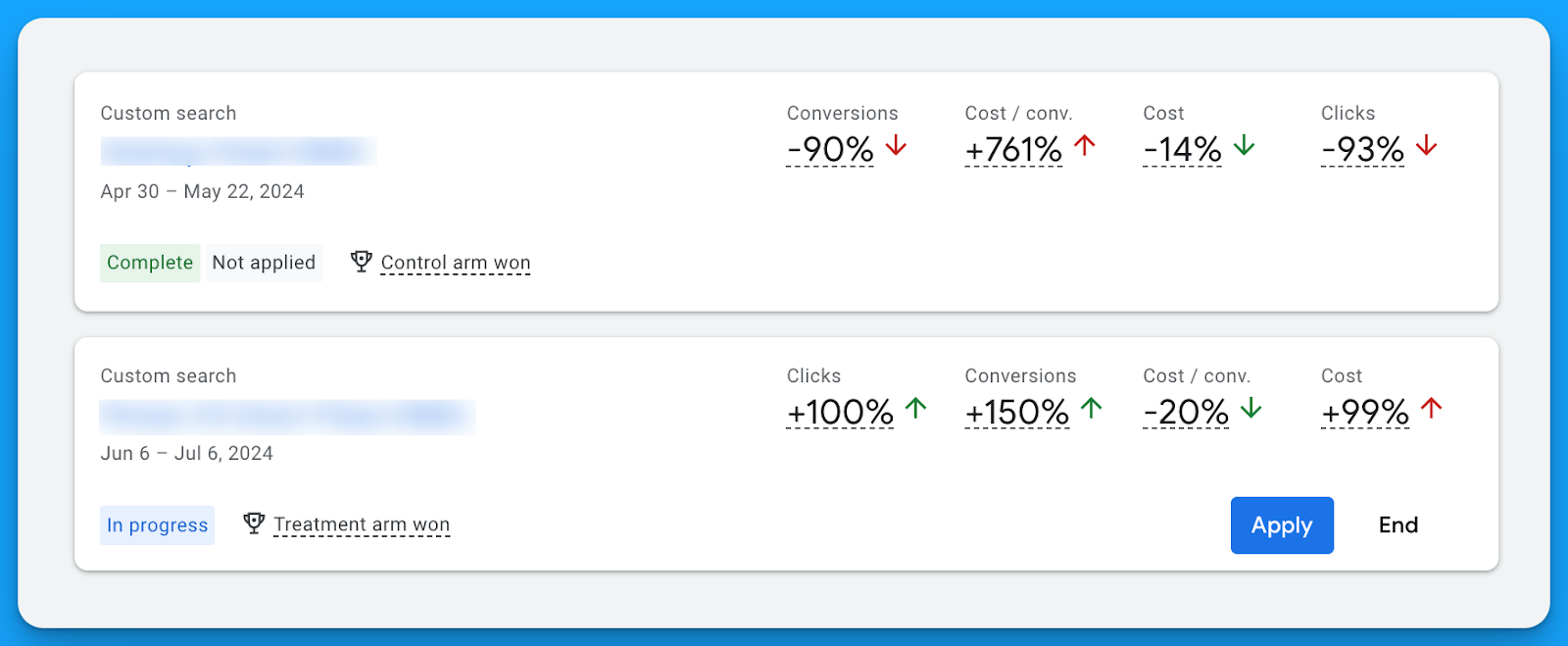
Using this feature build an experiment splitting the traffic by 50% for your original campaign vs the experiment version using broad match AND the targeted audiences you brainstormed in step 2.
Strategy #2: Advertising outside of English
English is the most competitive language in the world with the majority of advertisers.
We’ve seen reductions of up to 70% in our average CPC targeting other languages.
If your company has the resources to sell in multiple languages – take advantage of localization!
Localization campaigns are when you target keywords, write ad copy, and design landing pages that all are in your audience's native language (ex: Spanish, German, Portuguese).
You’ll reap the benefits of lower costs due to less competition.
The downside however with localization is search volume.
If you’re already advertising in English outside of North America and finding success, definitely recommend testing this strategy.
How to implement localized campaigns:
Step 1: Find proven converting phrase match keywords
Review your performance across converting phrase match keywords to identify which you’re going to prioritize testing with broad match discovery.
Don’t rely on “total conversions” make sure you’re viewing performance by keyword based on the custom metrics that matter for your business (ex: Demo, Trial, SQL, SAL, Opp, etc).

Step 2: Brainstorm your targeted languages
Ask your internal team what languages your sales team is able to sell in.
Based on your options make a list of potential languages.
Next, if you’re advertising outside of North America, review the top performing countries and identify their local languages and see if you have the internal resources that can speak that language.
If you can’t sell in this language then this strategy won’t make sense.
Step 3: Hire a local translator
Don’t make the mistake of relying on Google Translate to perform the bulk of your translation.
You’ll want to hire a translator that grew up in the area in which you want to advertise.
For instance, if you’re advertising in Portuguese.
The dialect for Europeans living in Portugal and those living in Brazil is very different.
A local Brazilian can tell if it’s not their dialect just like a native Portuguese.
I recommend hiring locals off Upwork can be as low as $12/hour depending on the language.
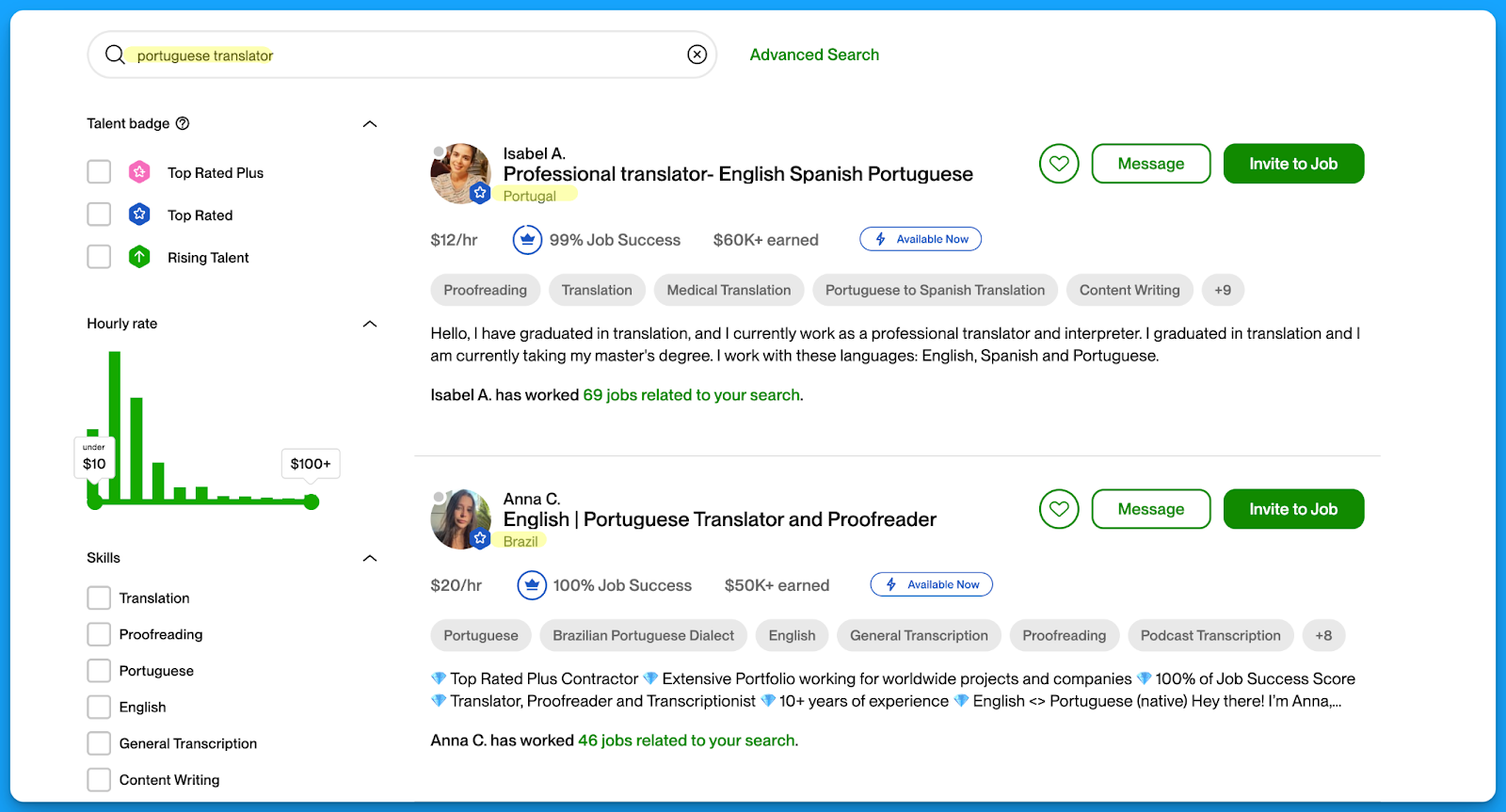
These translations will make a world difference in your ad and landing page copy.
Strategy #3: Industry campaigns
Industry campaigns can be great for coverage and quality.
This is where you’re going to bid on a desired keyword and add a related industry term.
For example, let’s say bidding on the keyword “crm software” here’s how you can modify this keyword to make it industry specific:
- healthcare crm software
- crm software for fintech
- crm software for small businesses
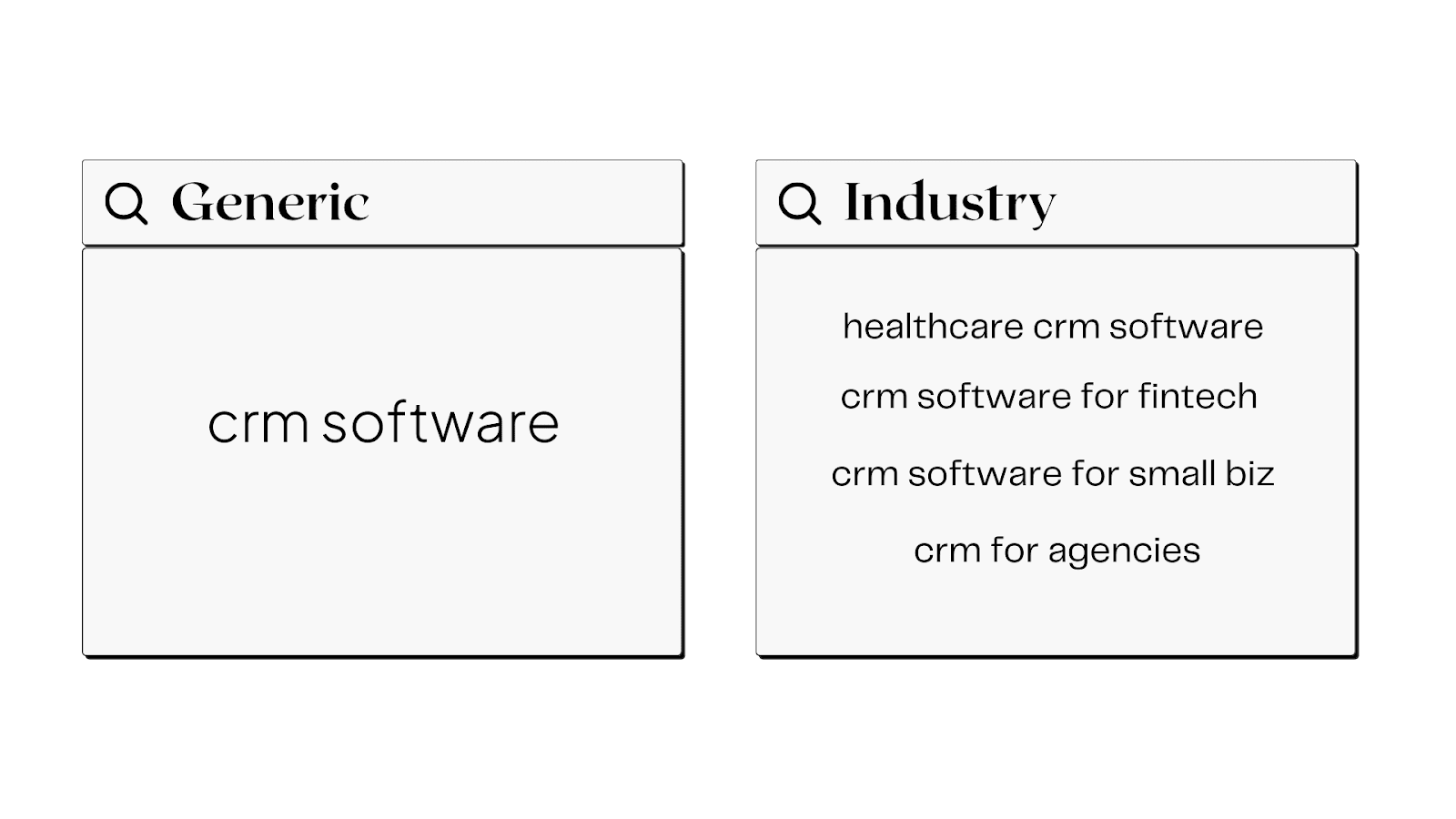
The benefits of industry campaigns:
- Personalized ad copy that can yield greater CTRs
- Higher quality leads due to a more qualified search term
- Lower cost per click prices due to less competition
The downside however is search volume (the constant struggle of Google for SaaS 😅).
How to implement industry campaigns:
Step 1: Find proven converting phrase match keywords
Just like the other strategies we’re going to identify proven keywords first that we can create industry variations for.
Step 2: Brainstorm your target industries
Run a win rate analysis in your CRM and understand which industries have the shortest sales cycles and largest deal sizes? Based on your findings, prioritise the industries in which you want to target.
Step 3: Build and prevent keyword overlap
Once you have your keywords and target industries you’re ready to build your campaigns.
Make sure to add your industry terms as negative keywords in your generic non-brand campaigns.
Otherwise you can have people seeing your generic ads for your industry terms.
Hope you found this article helpful!
Best of luck scaling your Google Ads campaigns for your SaaS.
From Clicks to Conversions: Master Google Ads for B2B 🔥
If you want to become a Google Ads pro, check out our free B2B Google Ads courses, where you'll learn how to launch, optimize, and scale your campaigns to drive pipeline and revenue.

Here's what you'll learn in each course:
⚙️ B2B Google Ads 101 - How to Launch Dangerously Effective Campaigns for Beginners
- The Googleverse: The Game You're Playing & How To Win
- Measurement: How to Make Sure You're Profitable
- Targeting: How to Show Up For the Right Searcher
- Planning: Putting It All Together
🎯 Google Ads 102 - How to Clicks Into Profit
- Visibility: How To Find the Hole Sucking Profits
- Workflows: How to Optimize On a Daily, Weekly, Monthly & Quarterly Basis
- Experimentation: How to Test & Automate Profitability
- Troubleshooting: How To Solve Inevitable Problems
🚀 Google Ads 103 - How to Scale Google Ads For Advanced Advertisers
- Methodology: How to Vertically Scale Google Ads From A-Z
- Campaigns: Scaling Horizontally Through Campaign Themes
- Channels: Scaling Outside of Paid Search
Click Here to Join 1,000+ B2B Marketers Today and start leveling up your advertising skill set.
Takes < 90 seconds to sign up (seriously we timed it 😂)
People Also Ask
How can I effectively measure the success of my Google Ads campaigns for SaaS products?
Utilize key performance indicators (KPIs) such as conversion rates, cost per acquisition (CPA), and return on ad spend (ROAS). Implement tracking tools like Google Analytics to monitor user behavior and campaign performance.
What are the best practices for creating compelling ad copy that resonates with my target audience?
Focus on highlighting unique selling propositions (USPs), addressing customer pain points, and including clear calls-to-action (CTAs). A/B testing different ad variations can help determine what resonates most with your audience.
How can I optimize my landing pages to improve conversion rates from Google Ads traffic?
Ensure landing pages are relevant to the ad content, load quickly, and have a clear, concise design. Incorporate strong CTAs and minimize distractions to guide users toward the desired action.
What role does keyword research play in the success of Google Ads for SaaS, and how should I approach it?
Keyword research is crucial for targeting the right audience. Use tools like Google Keyword Planner to identify high-intent keywords relevant to your SaaS product, and consider long-tail keywords to capture more specific search queries.

Join 0,000 B2B marketers leveling up their paid advertising skill set! 🚀
Become a part of the best B2B Ads community ❤️





%20-%20new%20v2.png)
